Physical Address
304 North Cardinal St.
Dorchester Center, MA 02124
A proactive low threshold for FIS (Flexible Intubation Scopes) use is important when considering a DA. Rigid VAL, Optical Laryngoscopes, or stylet use when FISs are indicated can worsen already grim situations and impede FIS rescue.
FIS instruments are frequently very delicate and expensive. However, balance FIS expenses against costs of multidevice airway rescue attempts; cardiac, airway, brain, psychological, and other system injuries; and litigation and reputation damages.
For planned intraoral local anesthesia (LA), consider giving an antisialagogue at least 15 to 20 minutes beforehand. Supplemental oxygen, sedative, opioid, and/or LA use depends on the patient’s situational urgency and respiratory status. Adequate LA helps prevent discomfort, psychological distress, hemodynamic changes, and lack of cooperation. If you are unfamiliar with an ATI technique, then we recommend the use of the Difficult Airway Society awake tracheal intubation (DAS ATI) guidelines as a source of recommendation for the best techniques for the procedure
During FIS techniques, single or combined supplemental oxygenation modes may be advantageous: high-flow nasal cannula, an oral catheter, nasopharyngeal airway, mask, mask plus continuous positive airway pressure (CPAP) (oral or nasal), or transtracheal oxygen therapy (TTO). Rarely, give oxygen via working channels as needed, if flows are appropriate and the view is definitely above the esophagus/stomach or a very narrowed glottis/trachea.
After laryngeal entry, follow three directions successively with an FIS to reach the trachea through nasal or oral routes. In the supine patient these are downward to the posterior oropharyngeal or nasopharyngeal wall, upward to the anterior vocal cord commissure, and downward to the wider posterior glottic entrance.
The number one cause of flexible bronchoscopic intubation (FSI) failure is inexperience as a result of insufficient training and practice. Performing FIS examination/intubation on healthy asleep patients is ethical. A routine equivalent to one use per week provides competence after 50 uses and expertise after 100 to prepare for successful FIS management when really needed.
Inferior preparation of patients, equipment, and personnel leads to difficulty in FSI use, if not failure. Optimize and individualize psychological preparation, antisialagogues, sedatives, opioids, equipment, and local anesthetics for each patient. Advise and show untrained personnel tongue pull, jaw thrust, midline maintenance of intubating oral airways, and FIS working channel local anesthetic injection maneuvers.
Keep options for combined FIS and the use of other airway devices, well prioritized for difficult intubation (DI), uncertain device placement, and rescue. Multimodal approaches are likely to impact patients with fluid-soiled upper airways and edema or many airway pathologies.
Uncommonly, the FIS can be at a disadvantage, having little innate ability to gently move larger soft tissue structures which may be present in the airway or in soiled airways secondary to its small viewing tip diameter. With other devices, FIS combinations may overcome these difficulties.
Patients with preexisting upper airway obstructive narrowing may have difficulty with nonhollow objects placed in the area. Avoid obstruction by speeding up maneuvers after respiratory tract entrance if change to a smaller FIS is unlikely to help.
Whereas experts continue to consider flexible bronchoscopic intubation (FSI) as the “gold standard” for difficult airways (DAs), this chapter aims to address both the fundamentals and the advancements in this technique and associated technologies. The fundamentals we describe aim to equip the airway practitioner with the knowledge to be able to understand and implement safe and effective use of FSI techniques, either awake or asleep, regardless of the clinical setting.
The first observations on the movement of the vocal cords were published by Manual P Garcia (a singing teacher) in 1854, who used a head-strap mirror to reflect sunlight onto an intraoral dental mirror. The Royal Society in London named him the “first laryngoscopist.” Using a blind digital technique, William Macewen completed the first tracheal intubation under general anesthesia (GA) and the first awake intubation for surgery and anesthesia in 1878. An accidental intratracheal esophagoscope insertion in 1895 prompted Alfred Kirstein to use one to perform the first “direct” laryngoscopy and invent a laryngoscope-like “autoscope.”
Bronchoscopy began to develop in 1887, when Gustav Killian extracted a foreign body from a farmer’s respiratory tract with a rigid bronchoscope. Chevalier Jackson modified it with a distal tungsten lightbulb and a working channel in 1904, resulting in a greater success rate of endotracheal intubation attempts.
In 1966 Shigeto Ikeda proposed ideas for the construction of a flexible fiberoptic bronchoscope (FOB) to two companies, Machida Endoscope and Olympus. Meanwhile, in 1967 Peter Murphy ingeniously used a choledochoscope for tracheal intubation. In 1968 Machida produced an extremely “bendable” guided FOB, featuring an eyepiece for seeing images transmitted along 15,000 glass fibers (14 µm in diameter, each), which Ikeda then passed through a rigid bronchoscope. Later that year, Olympus produced a more maneuverable FOB with a working channel. At the International Congress on Disease of the Chest, Ikeda’s new FOB distal airway pictures were instantaneously news-making revelations. He demonstrated stand-alone FOB insertion for tracheal intubation in many countries and published his experiences in 1971.
Over time, clinicians used FOB for diagnostic purposes, routine clinical practice intubations, and, eventually, DA management. The inherent superiority of the FOB forged its place as the first choice for difficult intubation (DI) and cervical spine risk cases and as a diagnostic/therapeutic tool for DA instrumentation, hypoxemia, high airway pressure, obstructive sleep apnea (OSA), infection, foreign bodies, airway stenosis, tracheomalacia, pulmonary tumors, and other abnormalities. Raj and colleagues promoted FOB assistance for double-lumen tube (DLT) placement. Ovassapian and colleagues further delineated advantages during one-lung isolation in 1987, , whereas Benumof and colleagues compared right and left DLT bronchial insertions to explain why the relationship of bronchial anatomy to DLT construction inevitably resulted in less successful right-sided DLT positioning.
In the 1980s the Asahi Pentax Company’s integration of FOBs with preexisting charge-coupled devices (CCDs) permitted video monitor airway viewing and heightened the educational and clinical utility of FOBs. Further developments rapidly ensued, with multiple sizes of FOBs, the addition of working channels allowing diagnostic or therapeutic use (beyond simply visualization), the addition of light-emitting diodes (LEDs), and full-color imaging. The most recent technological advancements in this space, and perhaps the most significant, include the introduction of micro video complementary metal–oxide–semiconductor (CMOS) chips for transmission. This has entered the market of “single-use devices,” resulting in entirely disposable nonfiberoptic intubation scopes or reusable flexible bronchoscopes with disposable, sheath-like protective barriers, with the former gaining increasing traction.
Ovassapian and colleagues were pioneers in FOB educational promotion through workshop training and simulation, popularizing effective techniques. Currently, the FSI is the “gold standard” for DI and part of a growing trend for combination with other airway devices in a multimodal approach to DA management.
Throughout this chapter, several terms are used that are increasingly being implemented in routine clinical practice. Flexible bronchoscopes are named so as they have at least one flexible portion, usually the tip, and are long enough to visualize the division of the trachea into the two main bronchi. As the use of fiber-optic technology is decreasing and the utilization of CMOS technology for flexible bronchoscopes grows, the term FOB should only be reserved for the former. Flexible scope intubation (FSI) as a term should be used when describing the tracheal intubation of a patient with an FIS. This can also be achieved in an awake, spontaneously breathing patient, in which case this is called awake tracheal intubation (ATI). When performed with a flexible intubation scope (FIS), this is referred to as ATI:FIS, and when performed with a videolaryngoscope (VAL), this is termed ATI:VAL.
Note that various terms for those who are considered airway providers will also be used synonymously in this chapter, including airway expert, specialist, endoscopist, operator, manager, or caregiver.
FISs, whether fiberoptic or not, are available from various manufacturers: Olympus (Olympus America, Center Valley, PA, USA), Karl Storz (Karl Storz GmbH & Co. KG, Tuttlingen, Germany), Pentax (Pentax Medical, Montvale, NJ, USA), Ambu (Ambu A/S, Ballerup, Denmark), Verathon (Verathon Medical, Bothell, WA), and Cogentix Medical (Minnetonka, MN, USA) ( Fig. 24.1 ).
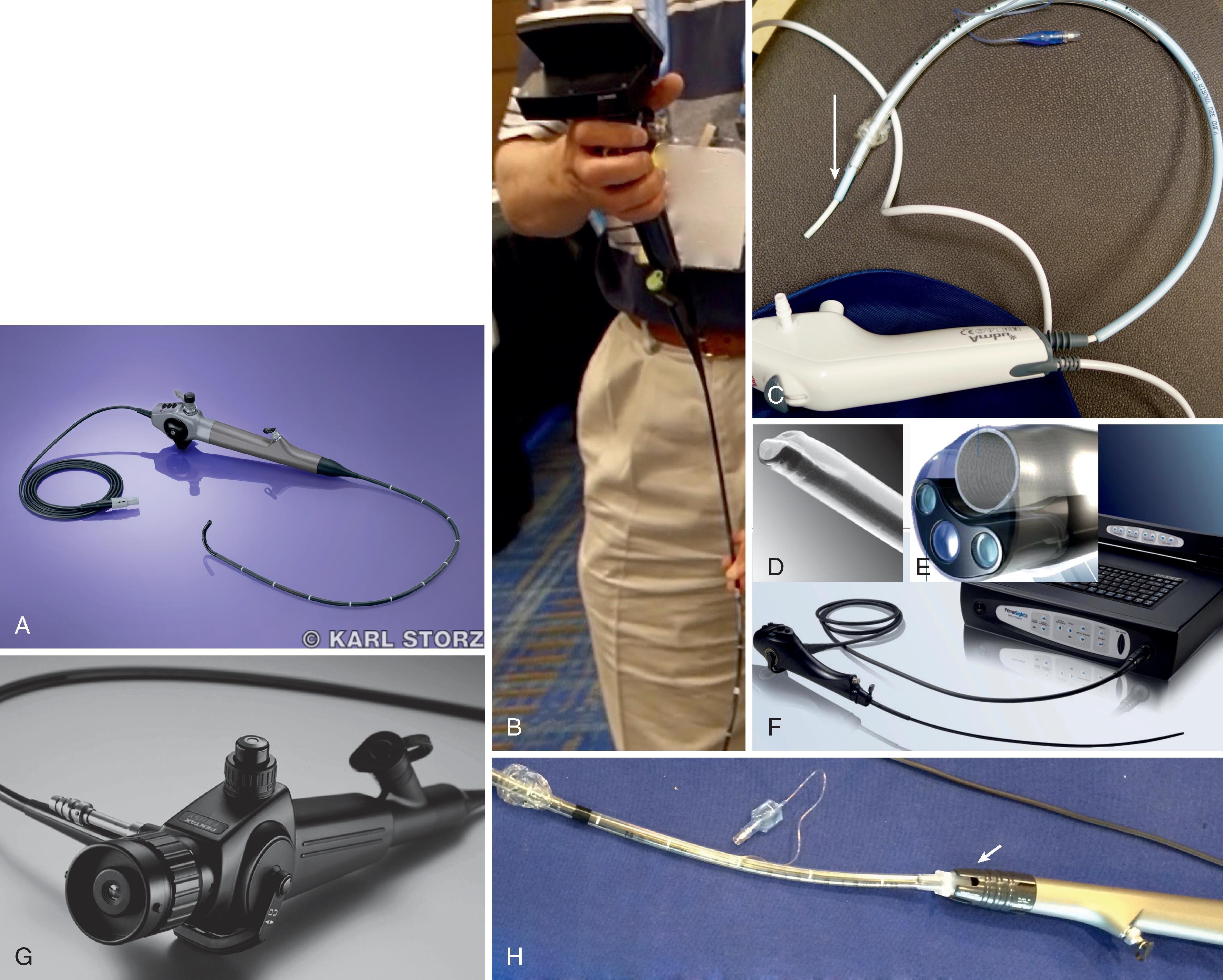
Note that for simplicity, whether fiberoptic or not, any such flexible scope will be referred to as an FIS unless otherwise indicated. Likewise, flexible bronchoscope intubation will have an FSI acronym.
Most reusable FISs cost thousands of dollars. They are quite delicate, except for nonfiberoptic ones, which are somewhat less harmed by bending. Disposable FISs are much cheaper per unit cost; however, there is some conflicting evidence on their cost-effectiveness as compared to reusable FISs. According to Tvede and colleagues, single-use FISs are not cost-effective if used more than 22.5 times per month. At that time, with expensive video monitors, reusables cost $219 per use, whereas disposables cost $252. This reusable cost was very much improved (<$160 per use) with an FIS care training program similar to that instituted by Lunn and colleagues, reducing normal repair costs of $51 per use by 84% to $8. Mouritsen and colleagues performed a detailed microcosting analysis of reusable versus single-use FISs in a London teaching hospital. The total per-unit cost of a single-use FIS was £220. When taking the potential costs of cross-contamination and infection of patients into account, this cost was estimated to be £511 per patient, compared to the unit cost of £200 for the single-use devices, which have no risk of cross-contamination if they are only used once.
All FISs have certain commonalities. There are three main parts: handle, insertion tube, and flexible tip ( Fig. 24.2 ). The handle has a battery-operated light source (allowing more portability) or an optical cable connection to an external light source. The handle’s “visual section” is the location of an eyepiece and lens, a video output adapter, or an actual video screen with an integrated camera (depending on the model). FISs with a CCD or CMOS camera chip at the tip have a wide-angle image and higher picture resolution compared with models having a narrower field of view and less optical detail ( Fig. 24.3 ). Video FISs are more useful clinically, particularly in teaching, as the instructor can view the endoscopist’s moves onscreen.
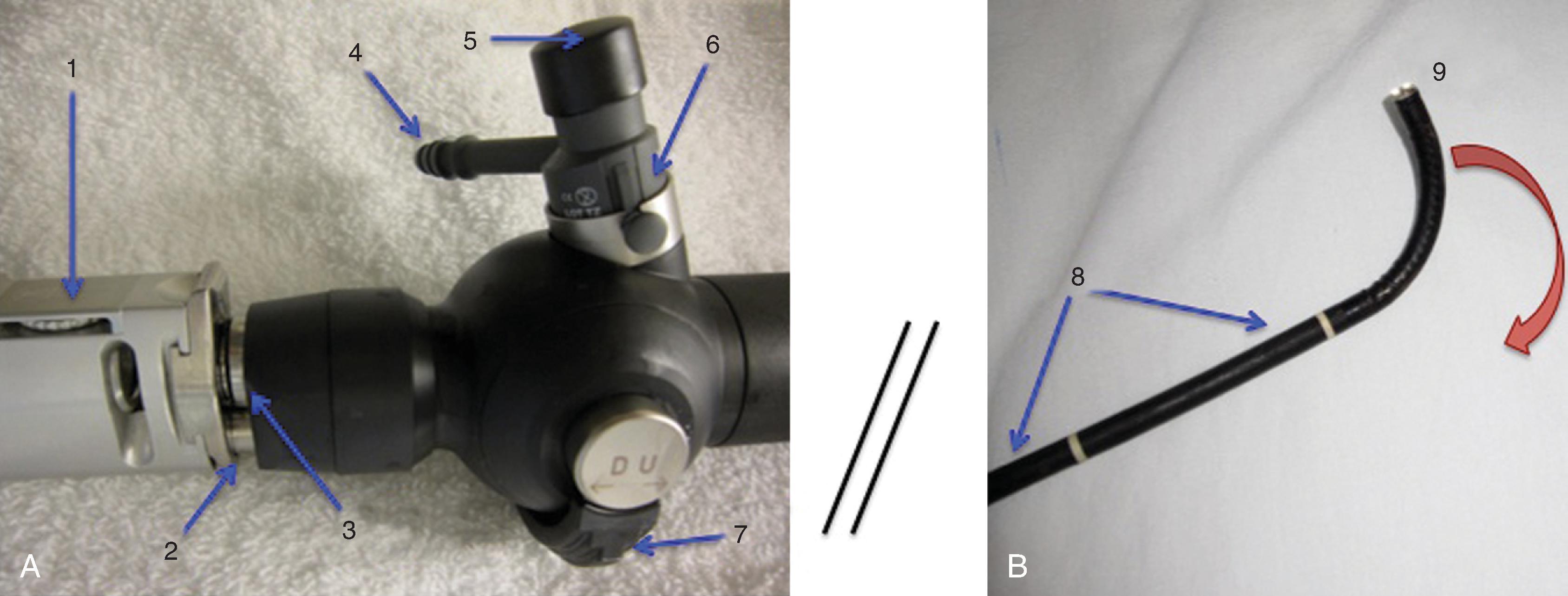
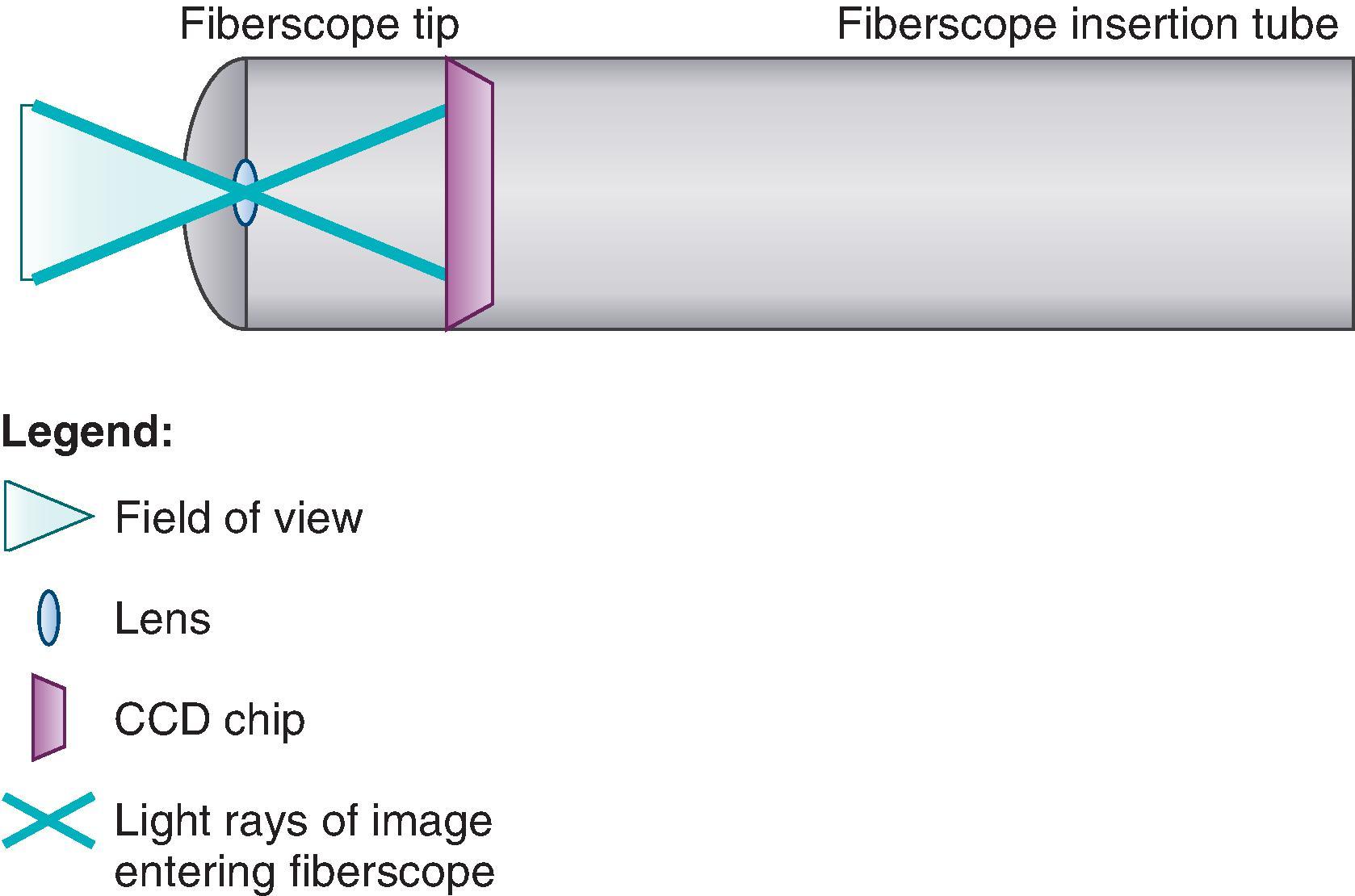
Many FISs have a visible black notch in the eyepiece at the 12 o’clock position to aid altered patient orientation (e.g., facing a sitting patient). Some models can rotate notches to give any desired orientation. Near the handle, an adjustable focusing ring or diopter can be fine-tuned to sharpen the image. This should be done prior to use to ensure the image is optimized. Some models have a venting ethylene oxide sterilization cap nearby.
The handle is attached to the insertion tube (second component) for entry into the patient. Its outer diameter (OD) determines minimum endotracheal tube (ETT) internal diameters (IDs) through which FISs can easily pass, usually a 0.3- to 0.5-mm difference. Insertion tubes average 50 to 65 cm in length with a flexible inner stainless steel mesh and a flexible water-impermeable outer plastic wrap.
Four specific elements traverse the length of fiberoptic insertion tubes in many reusable FISs ( Fig. 24.4 ). The first element allows light transmission toward the tip via one or two “noncoherent” fiberglass light guide bundles. A high degree of light intensity is focused within proximal light guide bundles, whereas heat filters or reflecting mirrors prevent damage to other insertion tube components.
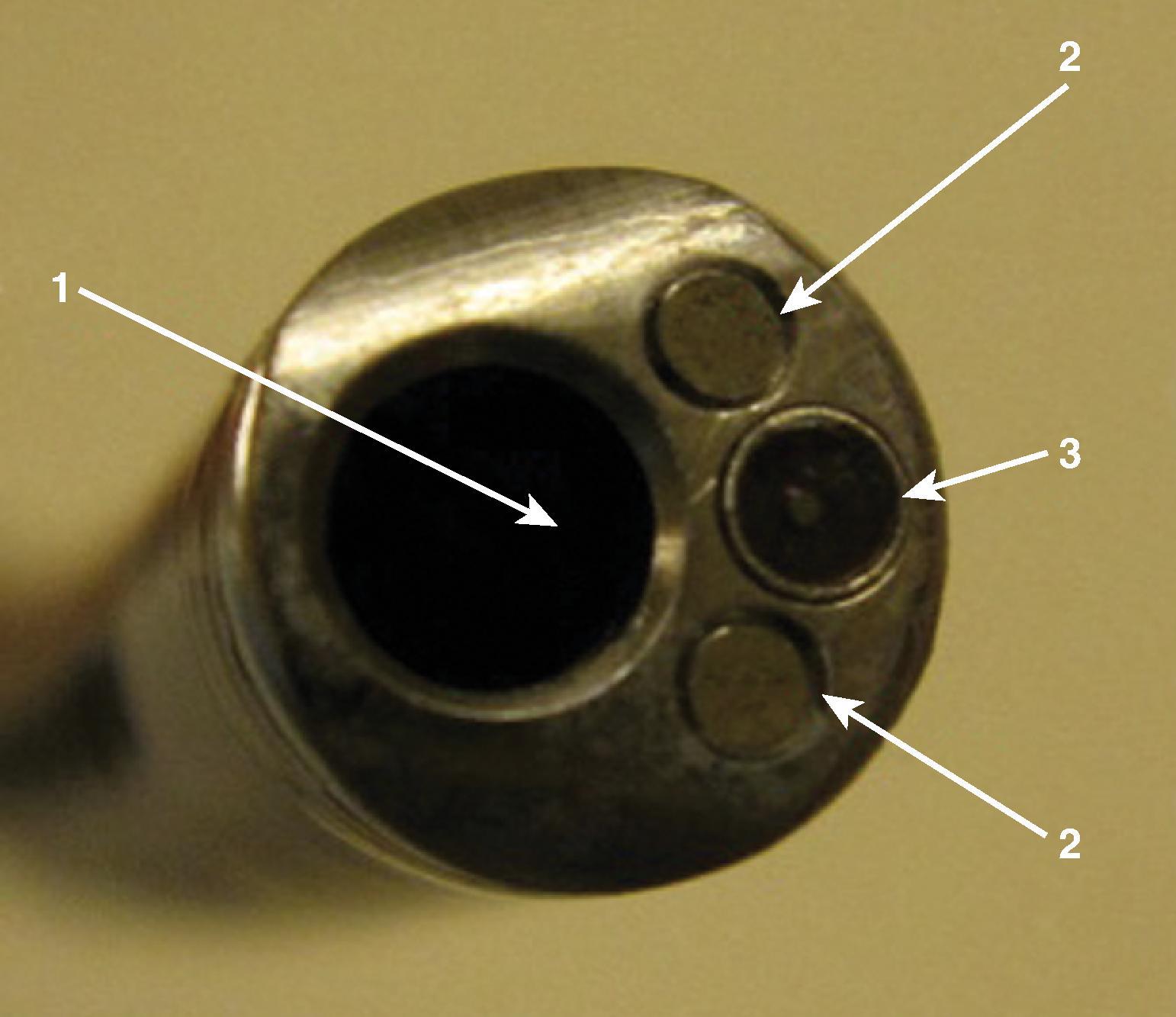
The handle’s lens and the tip’s objective lens are perpendicular to the insertion tube’s longitudinal axis, enabling transmission of identical, completely spatially oriented patient images between the lenses via “coherent” fiberoptic bundles. These involve 10,000 to 50,000 glass fibers, as small as 8 to 9 µm in diameter. As a reference, human hairs are 17 to 180 µm. A secondary layer surrounds each strand to reflect light internally and maintain intensity by preventing external absorption or light reflection off lateral surfaces. Broken fibers appear as black dots on the eyepiece or video screen. From excessive bending, dropping, or external pressure, these dots quickly increase to impair visual acuity and incur costly repair.
On the handle, up or down thumb motions move a bending or angulation lever to control the pulling of two angulation wires throughout the length of the insertion tube. Levering causes the FIS tip to move up to 240 to 350 degrees (amusingly, in the opposite direction to the lever movement [e.g., lever down = tip up]) (see Fig. 24.2 ). Angulation wires can be broken by excessive pressure (e.g., lever motion while the FIS tip is within the ETT lumen).
The fourth insertion tube element, a 1.2- to 2.8-mm-diameter working or suction channel, runs from the handle’s suction port to the FIS tip. When the port is attached to suction or oxygen tubing, the nearby spring valve is opened by index finger pressure for suctioning or oxygen administration. Alternatively, a syringe with medication can be attached to this port or a biopsy/injection port below (present in some models). When injecting, the endoscopist must ensure the suction is off to prevent loss of medication.
The distal FIS segment is a hinged, bendable tip with an objective lens (diameter of approximately 2 mm), fixed focal point, and short field of view (75 to 120 degrees) or a video chip (see Figs. 24.2 – 24.4 ).
Many FISs are available in premature infant to large adult sizes with varying fields of view, video monitors, closed-valve systems, and other features ( Table 24.1 ).
| Models | Unique Qualities | Light Source | External Diameter (mm) | Working Channel (mm) | Working Length (cm) | Tip Field-of-View Range (Degrees) | Range of Motion Up/Down (Degrees) |
|---|---|---|---|---|---|---|---|
| Olympus | |||||||
| LF-V | Fib; CCD | Electric | 4.1 | 1.2 | 60 | 120 | 120/120 |
| LF-DP, LF-GP, LF-TP | Fib | Battery/electric | 3.1–5.2 | 1.2–2.6 | 60 | 90 | 120–180/120–130 |
| LF-P | Fib; neonate | Electric | 2.2 | — | 60 | 75 | 120/120 |
| MAF-GM, MAF-TM | Fib/hybrid video; built-in screen; camera | Battery | 4.1–5.2 | 1.5–2.6 | 60 | 90 | 120–180/130–180 |
| BF-XP60, BF-3C40, BF-MP60, BF-P60, BF-IT60, BF-XT40 | Fib; designed for therapeutic application | Electric | 2.8–5.9 | 1.2–3 | Up to 55–60 | 90–120 | 180/130 |
| BF-H190, BF-1TH190, BF-Q190, BF-P190, BF-XP190 | HD and SD CCD video scopes for diagnostic therapeutic apps | Electric | 2.8–6.0 | 1.2–2.8 | 60 | 110–120 | 180–210/130–130 |
| BF-Q180-AC | Completely autoclavable; some have CCD; often for therapeutic applications (including intubation) | Electric | 5.3–5.5 | 2.0 | 120 | 180/130 | |
| Ambu | |||||||
| Ambu aScope | CMOS; disposable no suction | Battery | 5.3 | 0.8 | 63 | 80 | 120/120 |
| Ambu aScope Slim | CMOS; disposable suction + | Built-in LED | 3.8 | 1.2 | 60 | 80 | 150/130 |
| Ambu aScope 3 | CMOS; disposable suction + | Built-in LED | 5 | 2.2 | 60 | 80 | 150/130 |
| Karl Storz | |||||||
| K.S. 1130 AB | Fib; CCD | Battery/electric | 5.5 | 2.3 | 65 | 115 | 140/140 |
| K.S. 11301 BN | Fib; CCD | Battery/electric | 4 | 1.5 | 65 | 115 | 140/140 |
| Anticipating two more sizes (2.8 mm and 6.4 mm). | |||||||
| Expecting validation for the hands-free, brush-free EVOTECH system for reprocessing. | |||||||
| Video screen (4:3) format provides an overview of the working area (pixel-free and moiré-free). | |||||||
| Models | Unique Qualities | Light Source | External Diameter (mm) | Working Channel (mm) | Working Length (cm) | Tip Field-of-View Range (Degrees) | Range of Motion Up/Down (Degrees) |
| Pentax | |||||||
| FI-7BS, FI-7RBS | Fib; neonate; eyepiece; CVS | Battery | 2.4 | — | 60 | 95 | 130/130 |
| FI-9BS, FI-9RBS | Fib; eyepiece; CVS | Battery/electric | 3.1 | 1.2 | 60 | 90 | 130/130 |
| FI-10BS/FI-10RBS | Fib; eyepiece; CVS | Battery/electric | 3.5 | 1.4 | 60 | 90 | 130/130 |
| FI-13BS, FI-16BS | Fib; eyepiece; CVS | Battery/electric | 4.2 | 1.8 | 60 | 95 | 160/130 |
| FI-16BS/FI-16RBS | Fib; eyepiece; CVS | Battery/electric | 5.2 | 2.6 | 60 | 95 | 160/130 |
| EB-1570K | CCD; CVS | Electric | 5.1 | 2.0 | 60 | 120 | 210/130 |
| EB-1970K | CCD; CVS | Electric | 6.2 | 2.8 | 60 | 120 | 180/130 |
| Cogentix Medical | |||||||
| BRS-4000 | Fib; disposable EndoSheath with suction | Battery | Insertion tube, 4.1 | 1.5–2.8 | 57 | 95 | 215/140 |
| BRS-5100 | CVS | Insertion tube, 4.1 | 1.5–2.8 | 60 | 110 | 215/140 | |
Almost half a million bronchoscopies are performed per year in the United States. Whenever equipment is reused among different patients, there is a concern about avoiding communicable disease transmission. From 2000 to 2007, the American Association for Respiratory Care (AARC), American College of Chest Physicians (AACP), American Association for Bronchology and Interventional Pulmonology (AABIP), and Association for Professionals in Infection Control (APIC) issued guidelines and consensus statements to assist in the prevention of FIS-associated infection or contamination.
Although there are no reports of infection or cross-contamination caused by FIS intubation in an operating room (OR) or emergency room (ER), sporadic references testify to instances of contamination or infection after bronchial washing/lavage. Since the 1970s, contamination sources have included sentinel patients, contaminated water, inadequate sterilization techniques (attributed to insufficient quality or quantity of sterilizing solution), repeated use of cleaning fluid or brushes, automated endoscope reprocessors, and FISs with design errors or damage. Valves and working channels are the most suspected areas for ineffective FIS sterilization. Multiple organisms have been found, including Pseudomonas aeruginosa, nontuberculous mycobacteria, Serratia marcescens, Mycobacterium tuberculosis, Stenotrophomonas maltophilia, Legionella pneumophila, Rhodotorula rubra, Klebsiella species, Proteus species, and fungi.
With FIS usage, the involved clinical sites automatically fall under the aegis of mandatory universal precautions. Constant vigilance in care and high-level disinfection are imperative. Once used, an FIS should be directly handed off to trained assistants or placed in marked vertical holding tubes for rapid pickup (e.g., ProShield, Seitz Technical Products, Avondale, PA). To prevent damage, holding tubes should be long enough to handle FISs up to 65 cm.
Disinfection may take up to 45 minutes ( Fig. 24.5 ). Assistants should carefully insert a cleaning brush into portals to span the working channel’s length for the removal of secretions according to the manufacturer’s and/or health care institution’s instructions. Next, the entire FIS must be diligently inspected for damage, tears, indentations, or abnormalities. A leak test to detect holes in the insertion tube sheath is essential, and detected failures necessitate sending them for repairs without sterilization. Suction and biopsy ports must be disassembled. Nondisposable parts must be gently placed in glutaraldehyde, peracetic acid, orthophthaldehyde, hydrogen peroxide gas plasma, or another manufacturer-indicated solution. The working channel must be syringe-flushed with disinfectant according to instructions. The Olympus model BF Q180 is autoclavable.
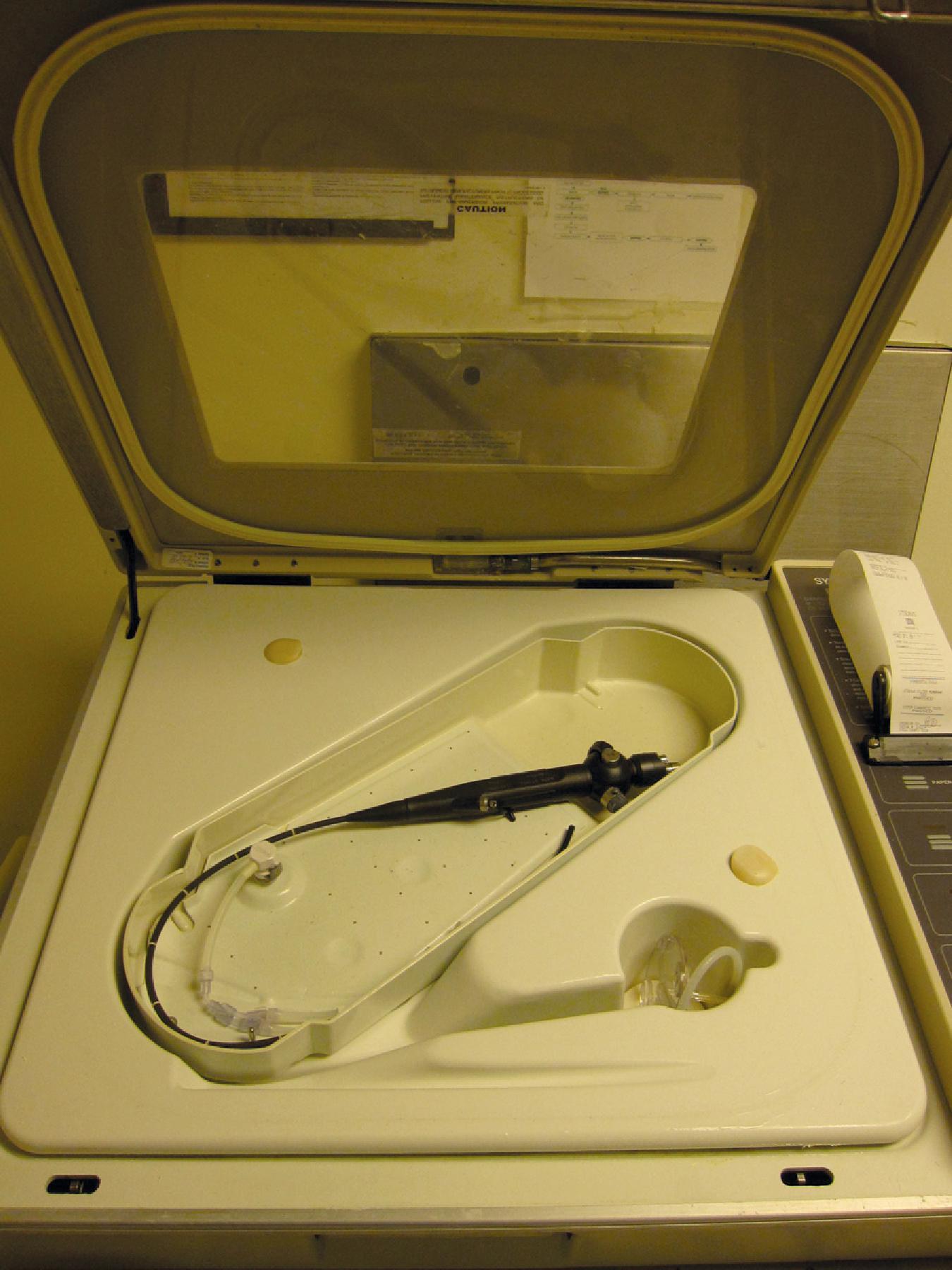
After the completion of sterilization, all parts must be removed to prevent caustic damage. The FIS should be gently washed and thoroughly rinsed with sterile water, including through the working channel to prevent residual chemical toxicity. It is mandatory to dry the channel by suctioning or purging with solutions (e.g., 70% alcohol) and compressed air, per instructions.
Most bacteria, fungi, and viruses, including human immunodeficiency virus (HIV) and hepatitis, are susceptible to sterilization processes. In patients with contagious diseases (e.g., tuberculosis) FISs may require lengthy ethylene oxide sterilization and aeration procedures for up to 24 hours, with the venting cap secured to a venting connector. In cases of suspected prion infection (e.g., Creutzfeldt-Jakob disease) or highly dangerous diseases (e.g., Ebola) avoiding FIS usage or using a disposable system is recommended.
Presently, routine surveillance cultures are not recommended by the AARC, AACP, AABIP, or APIC because of a lack of criteria to determine the testing frequency, relevance when positive results occur, courses of action, and costs of testing procedures. , However, bioburden testing is recommended whenever unusual rates of infection are found.
During handling and sterilization, keeping the FIS straight is extremely important. Once cleaned, it is preferably stored suspended by its handle in a moderately lighted, climate- and humidity-controlled, safe location. Close proximity to radiation should be avoided because of deleterious effects on FIS material.
Because efforts toward the production of a truly autoclavable FIS (e.g., Bronchosteril Endoscope, Andromis, Geneva, Switzerland) did not lead to a widely accepted device, other solutions aimed at the prevention of cross-contamination were developed.
The Slide-On EndoSheath is a clear, durable, presterilized flexible thermoplastic elastomer with a working channel (variable size) that snugly fits only its own adult nonchanneled PrimeSight FIS or FIS system. It potentially prevents the transmission of 27-nm-sized organisms and permits FIS availability in one-third of the time needed for sterilizing other FISs. , The length of time to check for breaches is unknown but can be done by instilling a methylene blue dye in the used sheath and sinking it in a water bowl. There are no studies on breach probability. Without breaches, this FIS is US Food and Drug Administration (FDA) approved for a wipe-down cleaning with the company’s product, making FOB damage unlikely. Advertised claims for all its various endosheathed devices (including uroscopes) boast “over 5-million sold, zero reported cross-contaminations.” It may reduce costs by requiring fewer FISs and limiting sterilization equipment or personnel needs. This is uncertain because its FIS has a 9-year lifetime, compared with FISs with up to a 15-year lifetime. , Presently, use is aimed more at intensive care units (ICUs), but other areas are possibilities; however, the use of these sheaths is becoming more and more obsolete due to the introduction of single-use FISs.
The Ambu aScope is a fully disposable, sterile, battery-operated non-FOB with a working channel. It has a CMOS chip, a steering button lever to flex the tip, and a distal LED ( Fig. 24.1 ). Images are transmitted along the insertion tube’s cable to a small portable monitor by way of a video connection cable at the handle. Its total disposability may be advantageous for patients with highly contagious diseases (e.g., Creutzfeldt-Jakob, Ebola), immunosuppressed patients, or in insufficiently funded sites.
Initial Ambu aScope 2 studies revealed little difference in intubation success rates for normal or DA patients, whereas optic quality and intubation times were better with reusable FISs, although since that study, they do now have a high-quality 12.8-in fully high-definition monitor. Kristensen and colleagues found the button system easy but had worse secretion problems compared with reusable FISs. The Ambu lens needed cleaning twice as often, with two completely blurred episodes after lidocaine instillation requiring FIS replacements.
Studies by Tvede (with his magic number of <22.5 cases/year for disposables to be less expensive), Aïssou, and Reynolds perceived almost no cost saving with it. , McCahon and colleagues paper might seem at odds to these studies, as their UK FIS costs per patient were almost double the Danish or French costs and more than triple Liu’s US and Reynolds’ Canadian costs. Mouritsen and colleagues’ systematic review and cost-effectiveness analysis found that single-use FISs are cost-effective and associated with a lower risk of infection. No comparative studies have better results for the Ambu aScope 3, with the exception of perhaps cost benefit.
Two other single-use FISs are now available, the GlideScope BFlex and the Storz single-use video endoscope ( Fig. 24.6 ).
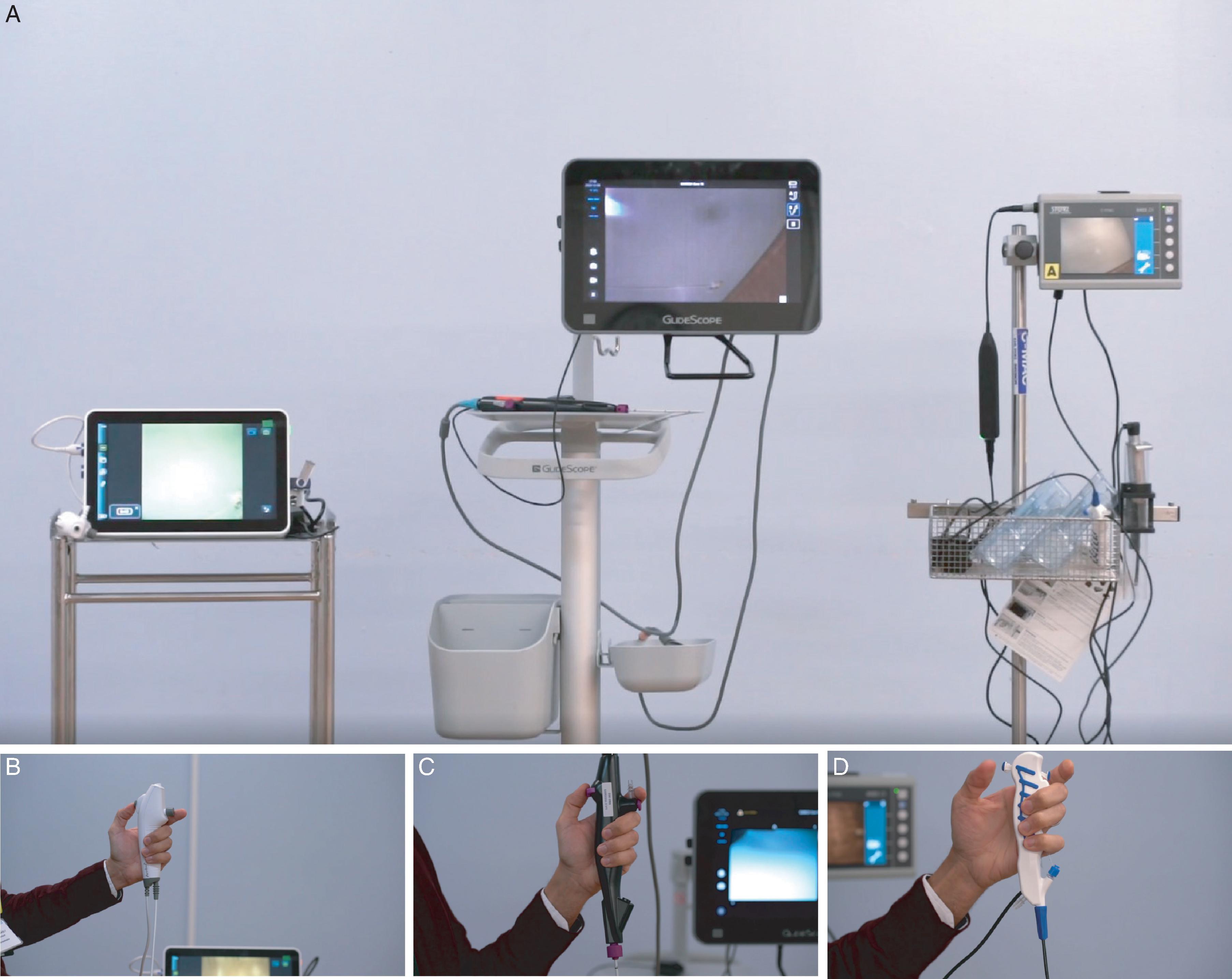
The BFlex is fully disposable and comes in three sizes (3.8 mm, 5.0 mm, and 5.8 mm), all three of which have working channels with 50-mm interval markings on the insertion tube. The internal CMOS camera offers excellent image clarity and the FIS connects via magnetic GlideScope QuickConnect technology to the GlideScope Core monitor, enabling the added advantage of a dual view with the GlideScope videolaryngoscope for viewing multimodal airway procedures. At the time of writing this chapter, there is no published data on this device comparing its performance to other single-use or reusable FISs.
The Storz single-use video endoscopes are also sterile packed and consist of a CMOS sensor and LED illumination to provide high-resolution images with good lighting conditions when attached to the C-MAC monitor or the Tele Pack. There are four sizes available (2.9 mm, 3.5 mm, 5.2 mm, and 6.5 mm), all of which have a working channel and working length of up to 65 cm.
Many professionals are concerned with the hazards of nonrecyclable product use; however, the materials in the aScope 4 Broncho generate less CO 2 emissions and utilize fewer scarce resources. All three companies involved in producing single-use FIS are working toward reducing CO 2 emissions, reducing PVC packaging, and increasing to 100% recyclable and compostable packaging.
Airway management failure is the bane of closed claims analyses. From 1975 to 1985, 34% of claims were attributed to DA; 70% involved death or brain damage. Between 1985 and 1992, 62% concerned death/brain damage after induction, whereas from 1993 to 1999, 35% suffered this outcome. In another analysis, between 2000 and 2012, difficult tracheal intubation claims were more likely to end in death than between 1993 and 1999 (73% vs 42%). However, permanent brain damage was similar between both time periods of the analyses.
Direct laryngoscope (DL) use had a DI incidence of 1% to 13%. Shiga and colleagues’ meta-analysis of studies on 50,760 patients estimated average DI occurrence at 5.8%, a range of 4.5% to 7.5%, , and an even greater incidence in obstetric or obese patients. , , Benumof’s estimate of “cannot intubate, cannot mask ventilate” frequency was verified by Heidegger and associates at 0.007%. , The overall published incidence of difficult face mask ventilation ranges between 0.66% and 2.5%, difficulty in placement or ventilation with supraglottic airways (SGAs) is between 0.5% and 4.7% and difficulty with tracheal intubation has been reported between 1.9% and 10%.
Despite the plethora of intubation devices such as intubating SGAs, lighted stylets, video-assisted laryngoscopes (VALs), optical laryngoscopes (OLs), and optical stylets and greater intubating success rates, FISs still have a place in the management of DAs in the form of ATI. Rosenblatt and colleagues’ survey of US anesthesiologists revealed a strong preference for FIS when managing patients with known DAs. Avarguès and colleagues’ survey of French anesthetists in 1999 revealed that 64% of responders voiced the need for more ATI training. In the revised 2013 Difficult Airway Algorithm (DAA) 69.7% of expert panelists formulating the American Society of Anesthesiologists (ASA) practice guidelines for DA management strongly agreed that FISs should be used for emergency noninvasive intubations. They also agreed that FISs should be readily available in most DA situations. In a 2009 review of existing DA management algorithms Frova and Sorbello affirmed that the FIS was universally recognized as the gold standard in awake, sedated, or anesthetized DI patients. No clearly validated predictive assessment tool developed specifically for ATI exists; therefore ATI must be considered in the presence of any predictors of DA management done during the airway assessment.
FISs have greater capability to rescue most airway device failures, including recently developed inventions, and facilitate successful airway management (either alone or in a multimodal approach), as illustrated by 13 DAA references, citing 87% to 100% success rates in DA patients.
Unique FIS characteristics compared with any other airway device include flexibility and ability to navigate along the most tortuous airways; least need for cervical motion, which is ideal for cervical spine risk cases; functional capability in any body position, oral or nasal route, and age; association with the most hemodynamic stability with the ideal local anesthesia (LA); and topicalization and capability in multimodal, troubleshooting, diagnostic, or therapeutic scenarios.
An ATI approach is usually chosen to avoid failure from an asleep intubation technique. An ATI technique should always be considered in the presence of predictors of DA management. For asleep FIS tracheal intubations, most anesthesiologists follow certain criteria, although many routinely employ this device. Asleep indicators include awake criteria (only if no adversity is likely) and more, as listed in Box 24.1 .
Routine intubation
Difficult intubation (DI)
History of prior DI
Suspected DI from patient history or physical examination
Rescue of failed intubation attempt
Intubation need in patients with preexisting Combitube or Rüsch EasyTube
Prevention of cervical spine motion in at-risk patients
Avoidance of intubation trauma because of existing anatomy (e.g., loose teeth, nasal polyps)
Avoidance of aspiration in high-risk patients
Diagnostic purposes
Troubleshooting high airway pressures
Troubleshooting hypoxemia
Observation for airway pathology (e.g., OSA, stenosis, tracheomalacia, vocal cord paralysis, tumors, pus, and so forth)
Removal of airway pathology (e.g., secretions, foreign bodies)
Therapeutic uses beyond planned FSI
Endotracheal tube exchange
Assistance with airway device placement (e.g., SGA, retrograde intubation, etc.)
Positioning of double-lumen tubes or bronchial blockers
Positioning of endotracheal tubes at specific depths
Intratracheal observation of initial tracheostomy instrument entry
The most important contraindication to FIS use is usually a lack of FIS endoscopist skill because of inadequate training or loss of formerly acquired skills. Relative contraindications depend on specific scenarios, such as the lack of trained assistance, unavailability of equipment, uncooperative patients, degree of known airway tract narrowing ( Fig. 24.7 ), or advisability that a different device may be better (a tracheotomy for excessively bleeding massive facial trauma). Contraindications for awake and asleep FIS intubation are listed in Boxes 24.2 and 24.3 , respectively.
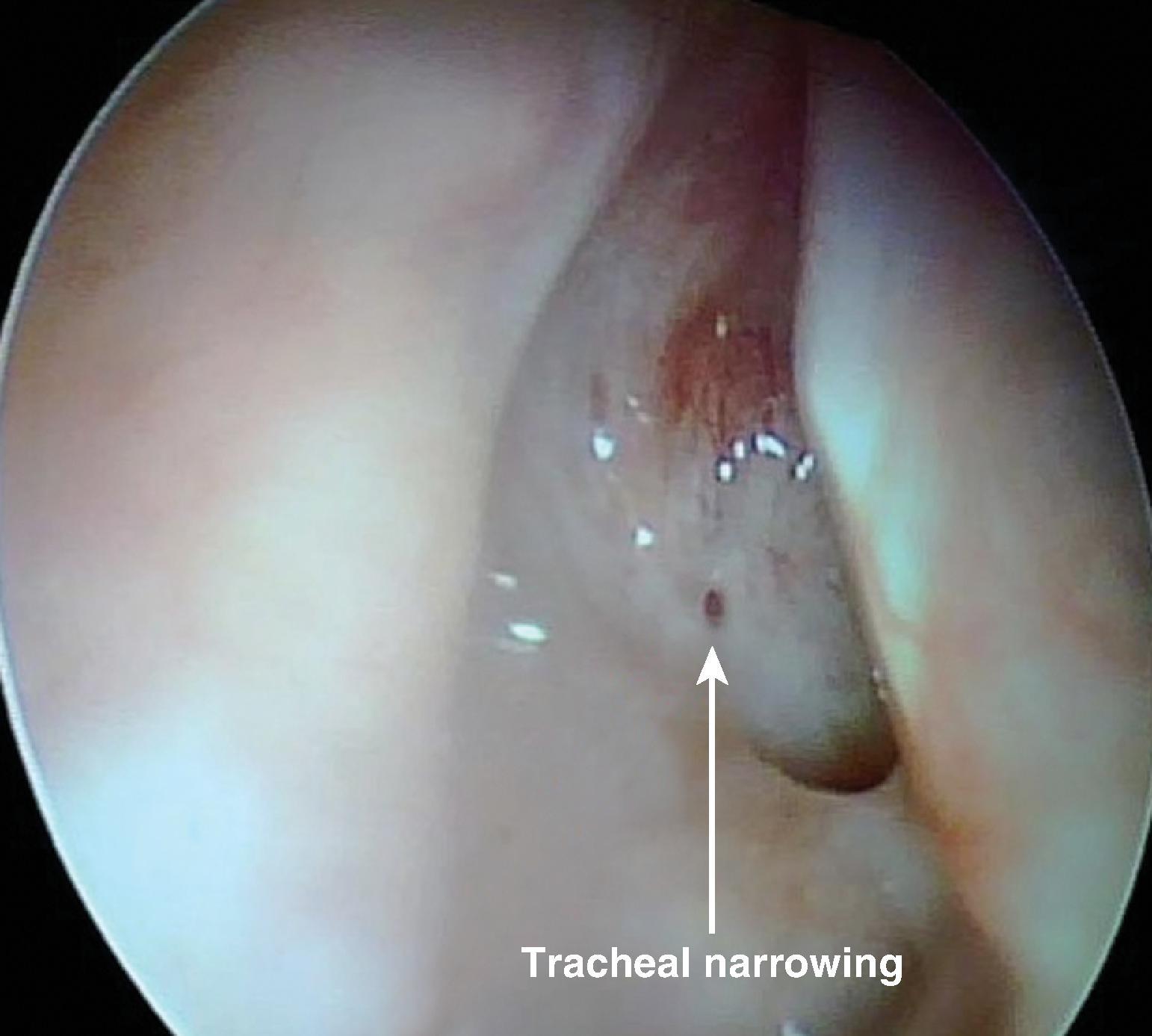
Absolute contraindications
Uncooperative patient
Lack of endoscopist skill, assistance, or equipment
Near-total upper airway obstruction, unless for diagnostic purposes
Massive trauma (but, if retrograde intubation is chosen, FIS may help; see text)
Moderate contraindications
Relatively uncooperative patient
Obstructing or obscuring blood, fluid, anatomy, or foreign body in the airway that might inhibit success
Very small entry space
Relative contraindications
Concern for vocal cord damage attributed to blind ETT passage over the FIS
With some perilaryngeal masses, blindly advancing the ETT can “cork out” or seed the tumor (this situation should be discussed with the ENT specialist, if possible)
Documented or suspected nonconventional infectious agents, agents resistant to multiple drugs, or infectious diseases in the absence of a disposable device
Absolute contraindications
Lack of endoscopist skill, assistance, or equipment
Near-total upper airway obstruction, unless for diagnostic purposes
Massive trauma (but, if retrograde intubation was chosen, FIS may help; see text)
Moderate contraindications
Too high an aspiration risk or too difficult an airway
Inability to tolerate even a short period of apnea
Obstructing or obscuring blood, fluid, anatomy, or foreign body in the airway that might inhibit success
Very small entry space
Relative contraindications
Concern for vocal cord damage that might be caused by blind ETT passage over the FIS
With some perilaryngeal masses, blindly advancing the ETT can “cork out” or seed the tumor (this situation should be discussed with the ENT specialist, if possible)
Documented or suspected nonconventional infectious agents, agents resistant to multiple drugs, or infectious diseases in the absence of a single-use device
FIS specifications and characteristics are presented in Table 24.1 . Some have eyepieces or video attachments and varying degrees of portability. Olympus developed a very portable MAF-GM FIS system featuring a lithium rechargeable battery with a fixed, rotatable video screen by the handle, all totally immersible for sterilization. Its CCD camera has a memory card and an xD chip for still photography and video recording. One model is autoclavable.
Preparation is the springboard for FSI success. Mobile FSI carts must be readily and rapidly transportable for routine or emergency use. Carts can be used for institutional education programs or teaching workshops. Logical, instantly recognizable content arrangement must be uniform across facilities. Preferably, carts have two widely separated tubular structures for hanging clean or used FISs ( Fig. 24.8 ). Typically, they include a light source, video monitor (ideally), endoscopy masks, intubating oral airways (IOAs), bite blocks, atomizers, tongue blades, cotton-tipped swabs, gauze, soft nasal airways, alcohol wipes, bronchoscopy swivel adapters, and local anesthetics. Organizational updates lie within the anesthesiology purview
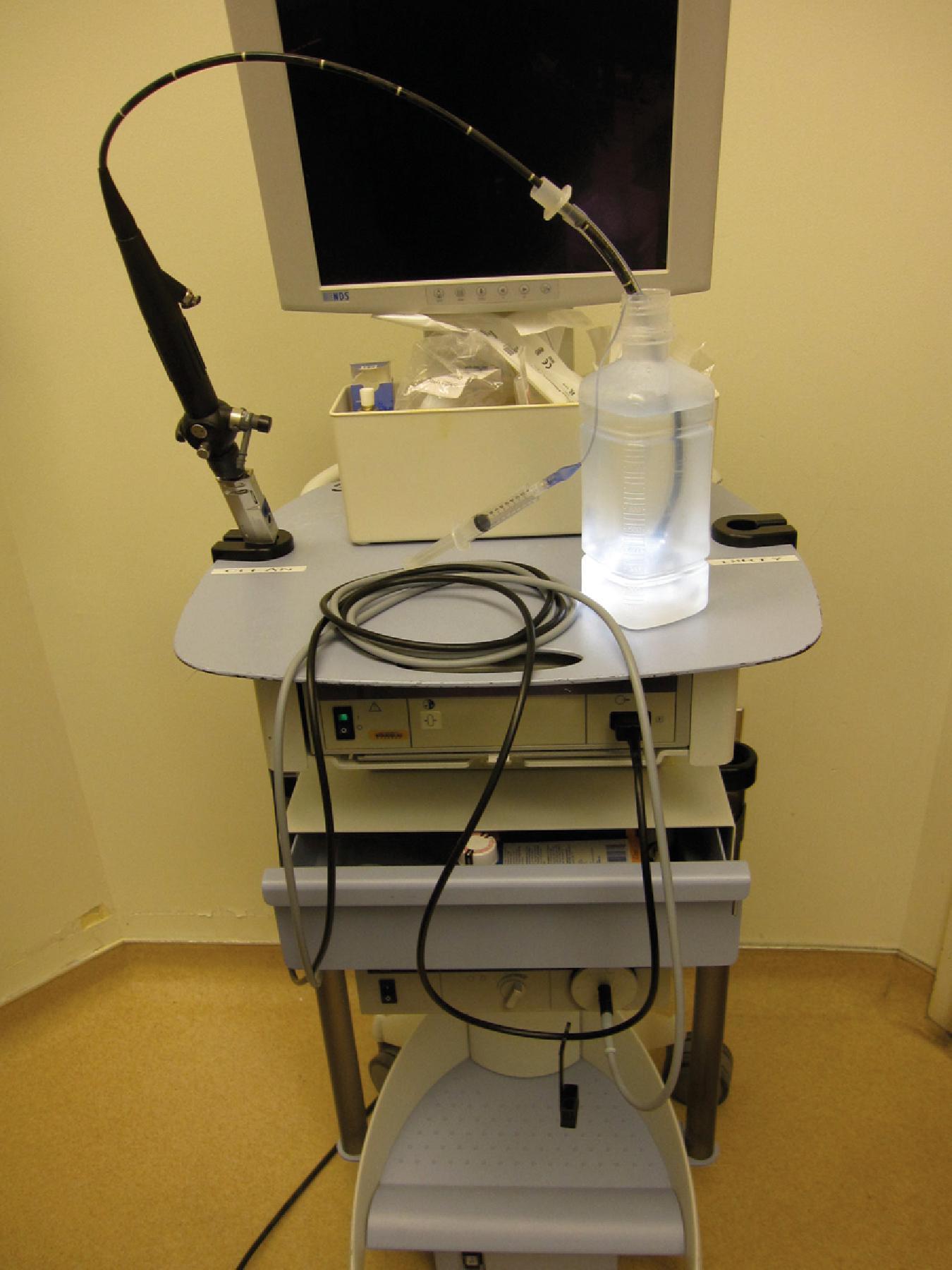
Optionally, FSI cart setups can exist within a DA cart, having items needed to follow the DAA (VAL and screen, SGAs, intubating SGAs, ETT introducers/exchangers, and invasive airway rescue sets). , With the increased availability, accessibility, and reduced cost of single-use FIS compared to reusable FIS, many institutions have these on their carts as there is no need to sterilize the bronchoscopes and they can be rapidly assembled if required in an emergency.
Bronchoscopy swivel adapters are used for diagnostic examinations, therapeutic maneuvers, or intubation. They can rotate when placed between the ventilating system and a mask, SGA, or ETT. They resemble elbow adapters equipped with a flip-cap port on top, covering a centrally open diaphragm ( Fig. 24.9 ). This facilitates FIS passage with virtually no leak during uninterrupted ventilation. Swivel adapters only permit very small ETT passage (sizes ≤5.5 mm; uncuffed 6.0 mm is very snug). Apart from a ventilation connection, endoscopy masks have more than one larger opening whose design function may be similar to a swivel adapter port ( Fig. 24.10 ). This allows FIS or FIS and ETT (≤8.0 mm) passage during continuous mask ventilation. Some have recessed valvelike openings.
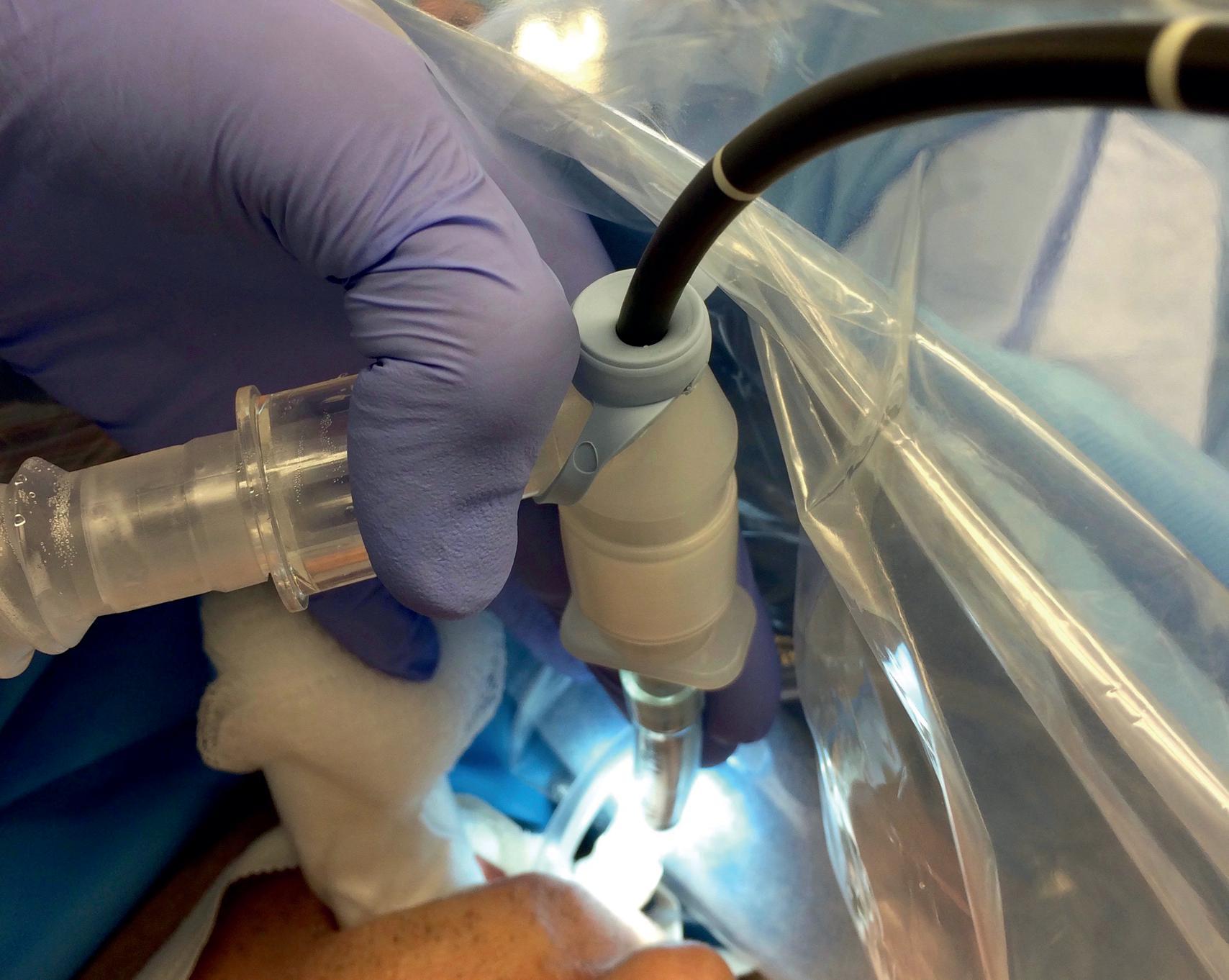
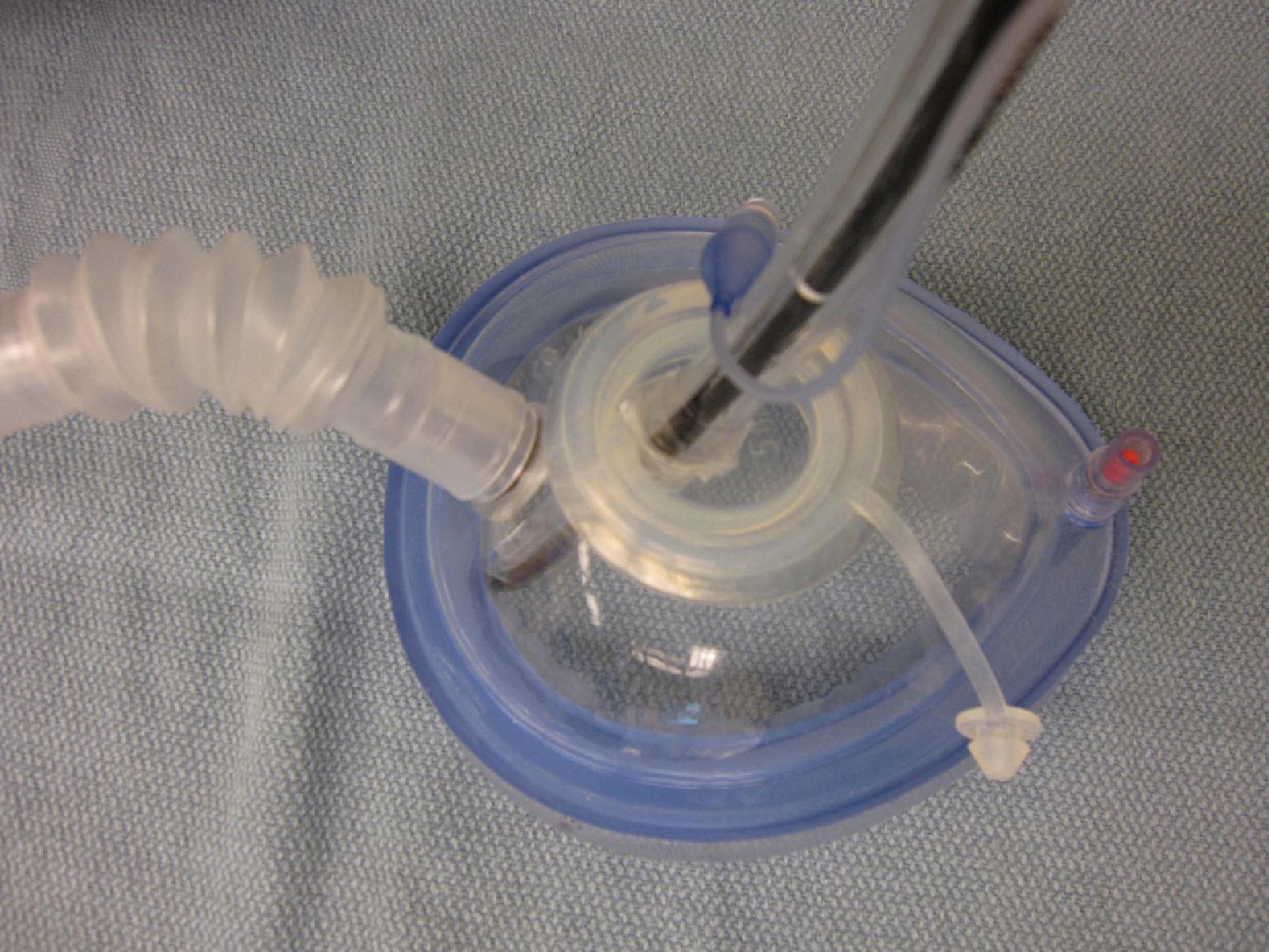
For conscious or unconscious patients, IOAs are conduits to keep an FIS midline during oral intubation ( Fig. 24.11 ). They must not be placed too deeply into small mouths.
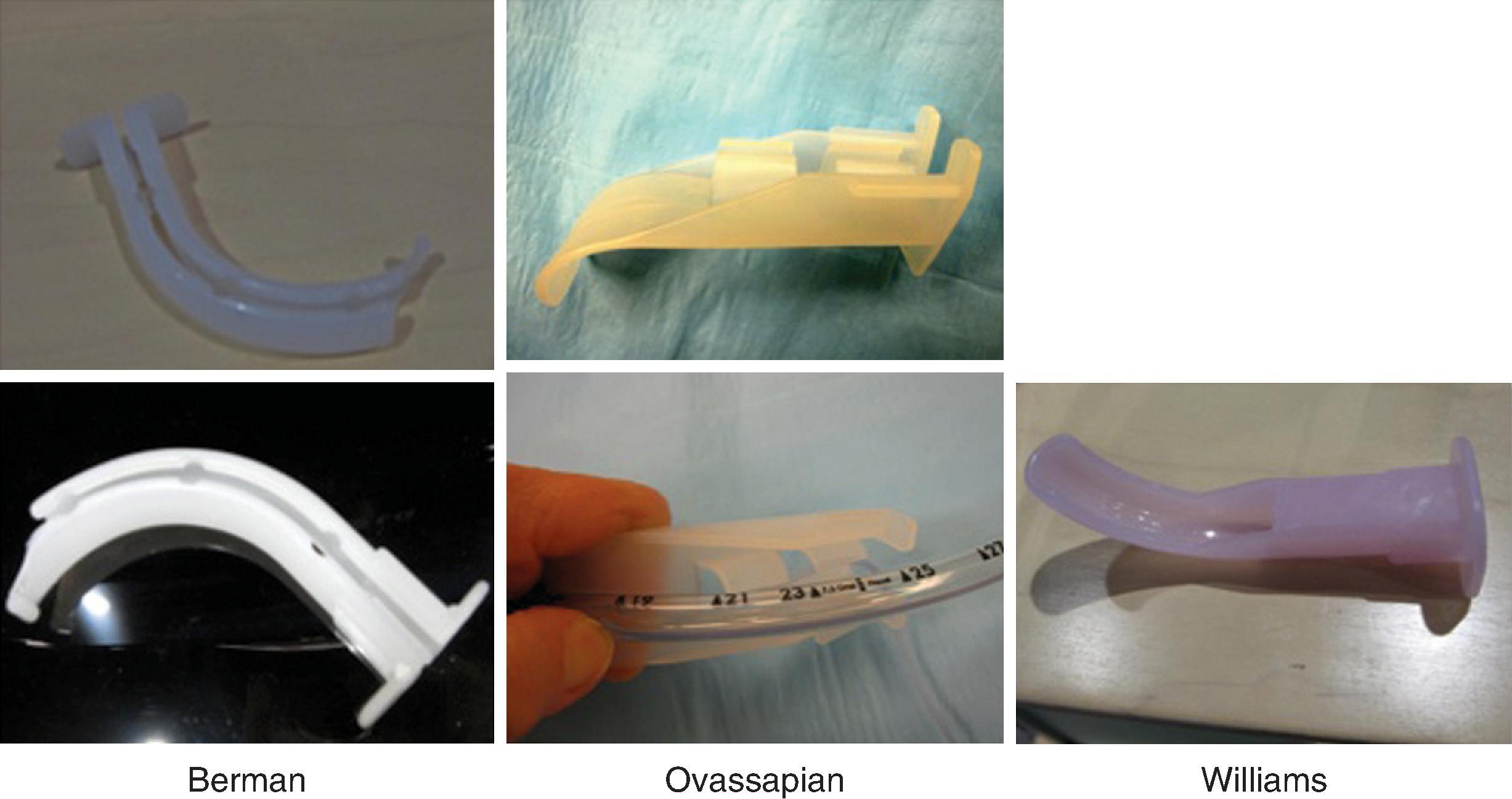
The ideal IOA (1) protects the FIS from damage; (2) keeps it midline; (3) keeps tissues away; (4) permits FIS maneuverability within; (5) has an ideal length to approach the glottis; (6) allows the passage of larger ETTs; (7) possesses a breakaway quality for easy removal; (8) avoids tissue discomfort (minimizing gagging) or trauma to tissues or ETT cuffs; and (9) has the ability to assist with mask ventilation. If no IOA is used in awake patients (because of unavailability, endoscopist preference, or inadequate mouth opening), a bite block between the molars or incisors may prevent FIS damage.
Most studies comparing IOAs involve non-DA patients. All are disposable, except the aluminum Patil-Syracuse oral airway (Anesthesia Associates, Inc. [AincA], San Marcos, CA).
The Berman Intubating Pharyngeal Airway (Teleflex Medical Research, Triangle Park, NC) in neonatal, child, and adult sizes admits ETTs up to 8.5 mm. Its full-length tubular shape does not help FIS maneuvering, but its wide lateral perforated slits break away from postintubation ETTs (although possibly difficult, particularly with periglottic ETT impingement). Kept midline, it provides a better lead to the glottis if the length is appropriate. If too long, distally, it may lie in the vallecula; 1- to 2-cm withdrawal may rectify the situation. This device has largely been superseded by newer IOAs.
The proximal channel of the Ovassapian Fiberoptic Intubating Airway (Teleflex Medical Research, Triangle Park, NC) permits the passage of ETTs up to 9 mm. It has flexible lateral walls and a posterior opening for easy ETT removal. Its distal half has a wide, flat, open, curved area designed to keep the tongue and soft tissues away, make it easier to stay midline, and permit free FIS movement. A marker line drawn lengthwise down the middle of its concave surface aids FIS orientation upon entry. During ETT insertion between the teeth, the channel can be partially opened to avoid tearing the cuff on its corners.
The Williams Airway Intubator (SunMed Medical Systems, Grand Rapids, MI) has two adult sizes, allowing the passage of an ETT up to 8.5 mm. It has a closed channel proximally and a curved section distally with a scalloped opening on the lingual surface to permit FIS movement. If kept midline and its length is appropriate, it may be the best guide to the larynx. If the length is too long, visualization can be problematic. With smaller sizes, cuff damage is more frequent for ETTs larger than 7.0 mm. During removal, which may be difficult, the enclosed channel part should have been liberally prelubricated. Afterward, reconnect the ETT to its 15-mm ETT connector.
Two nasopharyngeal airway (NPA) techniques may be employed during ATI. One simplifies nasal ATI by making a breakaway NPA with a single full-length slit to permit breakaway capability, as reported by Lu and colleagues. Lubricate the breakaway NPA inside and outside, gently insert it into the largest naris to an appropriate depth, and guide the FIS through it toward the glottis. After maximal entry into the trachea, an assistant strips the NPA away. Advance the FIS until two to three rings above the carina and railroad the ETT into the trachea.
The second technique is where the NPA is used as a conduit for oxygen delivery and possibly for inhalation of volatile anesthetic gases during FSI (most commonly in pediatric patients). , This is particularly advantageous in spontaneously breathing patients after cutting a Murphy eye-type hole distally. Place this modified NPA into one nostril, and attach it to a supported breathing circuit via a 15-mm ETT adapter. Perform ATI through a different airway opening.
The appropriate selection of the most appropriate ETT is integral to the success of an ATI. Consideration should be given to the appropriate tube material, size, tip shape and design, and length of the ETT. Regular polyvinylchloride (PVC) ETTs can be used for FSIs. However, the most distal ETT tip area can get caught on the arytenoids, especially the right, causing impingement. Previously, ETTs with soft centrally directed tips had greater successful intubation rates than PVC ETTs. However, Joo and colleagues demonstrated no difference in success rates or manipulation instances required during ATI when comparing these two types of ETTs if the PVC ETT tip was inserted with the Murphy eye facing anteriorly with respect to the patient’s body to avoid arytenoid contact. It represented a 90-degree counterclockwise rotation of the ETT from its normal position during direct laryngoscopy ( Fig. 24.12 ). Reinforced Parker Flex-Tip and the ETTs used with intubating laryngeal mask airways have good clinical evidence to be superior to regular PVC ETTs and are recommended over them.
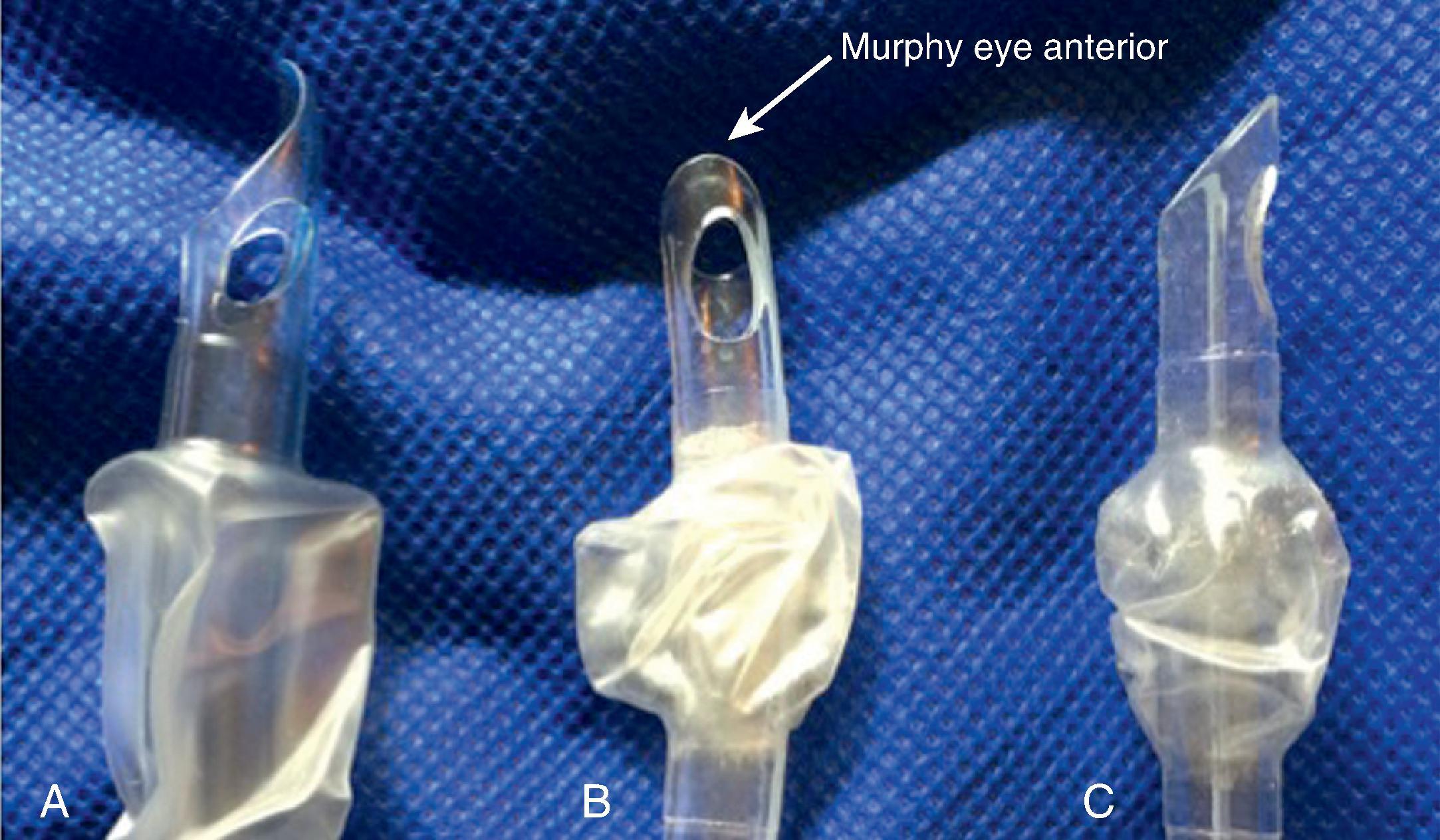
The principles of ATI can be broken down into four key elements: oxygenation, topicalization, sedation, and procedural setup and performance ( Fig. 24.13 ).
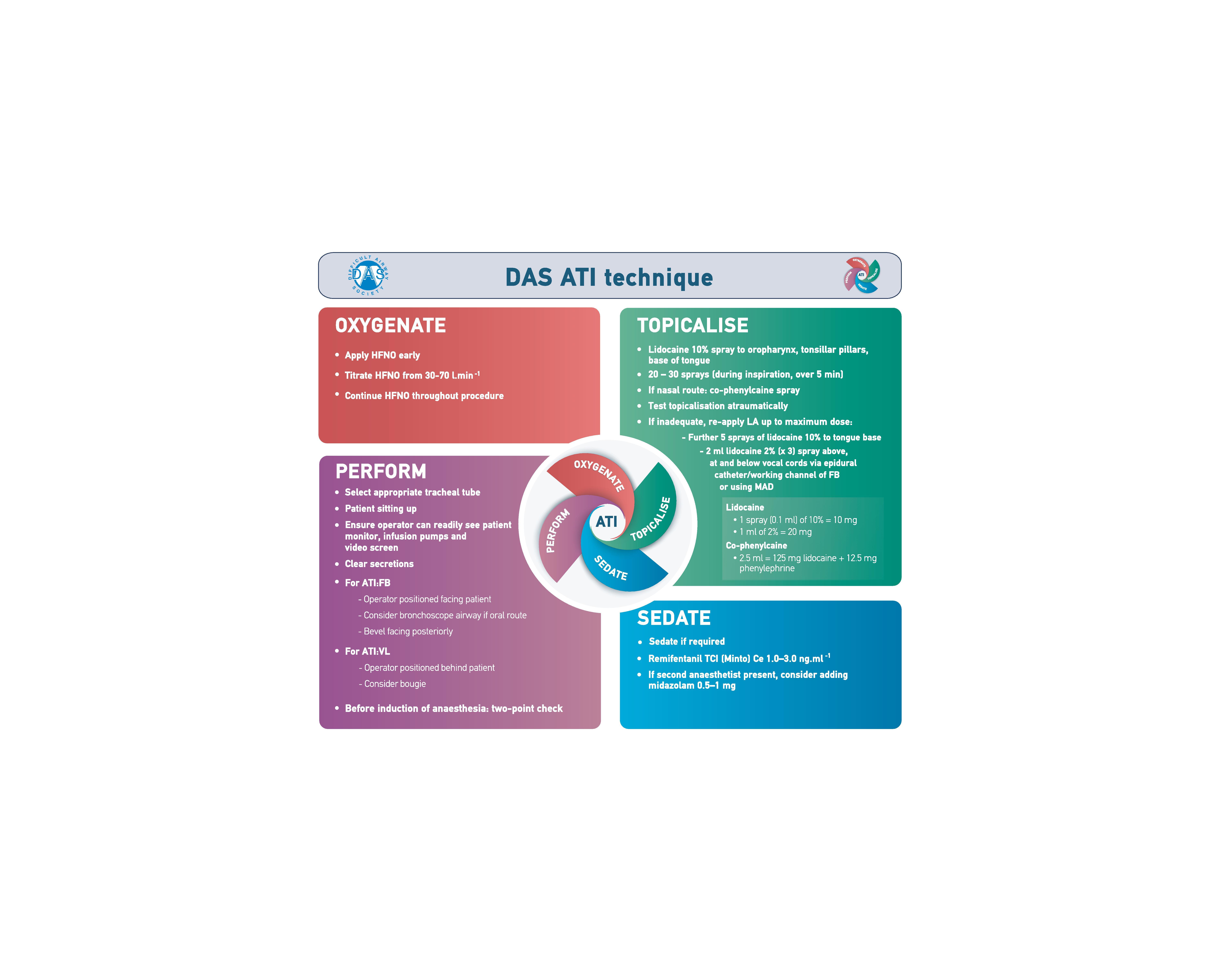
ATI is associated with greater physical and psychological stress on operators than any other airway management intervention. These stressors may adversely impact performance and increase the risk of complications. Thus effective communication, teamwork, and patient and operator preparation are critical. Moreover, having competent assistance, available expertise and support, and an environment that is geared toward safety is essential.
Planning for the appropriate location and prerequired equipment, drugs, and staffing is essential. Ideally, ATI should be performed in the OR environment as this affords access to DA carts, skilled assistance and nursing, proximity to other anesthesiologists, and surgical skills, as well as providing adequate space for ATI to be performed. Early communication with the OR is important to ensure that sufficient time is planned for DA management. External pressure from nonairway managers must be limited gently but firmly.
The importance of building a good patient rapport and psychological preparation cannot be understated. This includes highlighting the importance of advanced airway management in that patient, as well as the risks of the alternative airway management approaches. Specific descriptions regarding the benefits of ATI and the process that the patients are likely to experience should be discussed. Patients should be informed of the unpleasant flavors of local anesthetic; comparing to “tonic water” or “old banana” may be useful. Encouraging the patient to participate in the process by advising them that they will be requested to take deep breaths at certain times or gargle then swallow at others. It may be beneficial to highlight that the procedure may be performed without any sedation if appropriate topicalization is performed, but with conscious sedation, if indicated, patients are often relaxed and may not remember it. Finally, the importance of patient participation and cooperation cannot be understated as it makes the procedure easier, faster, and less worrisome.
The ergonomics of the clinical workspace have been shown to affect technical procedures and patient safety. , Consideration must be given to the placement of the following in the clinical environment: patient, operator, assistant, monitor, bed, airway trolley, anesthetic machine, suction, and infusion pumps. There are benefits and limitations to performing ATI facing the patient or behind the patient, as well as the patient position being supine or semirecumbent, although there are theoretical safety benefits to the latter. Regardless of patient and operator position, it is useful to consider the ergonomics of the clinical workspace ahead of the arrival of the patient ( Fig. 24.14 ).
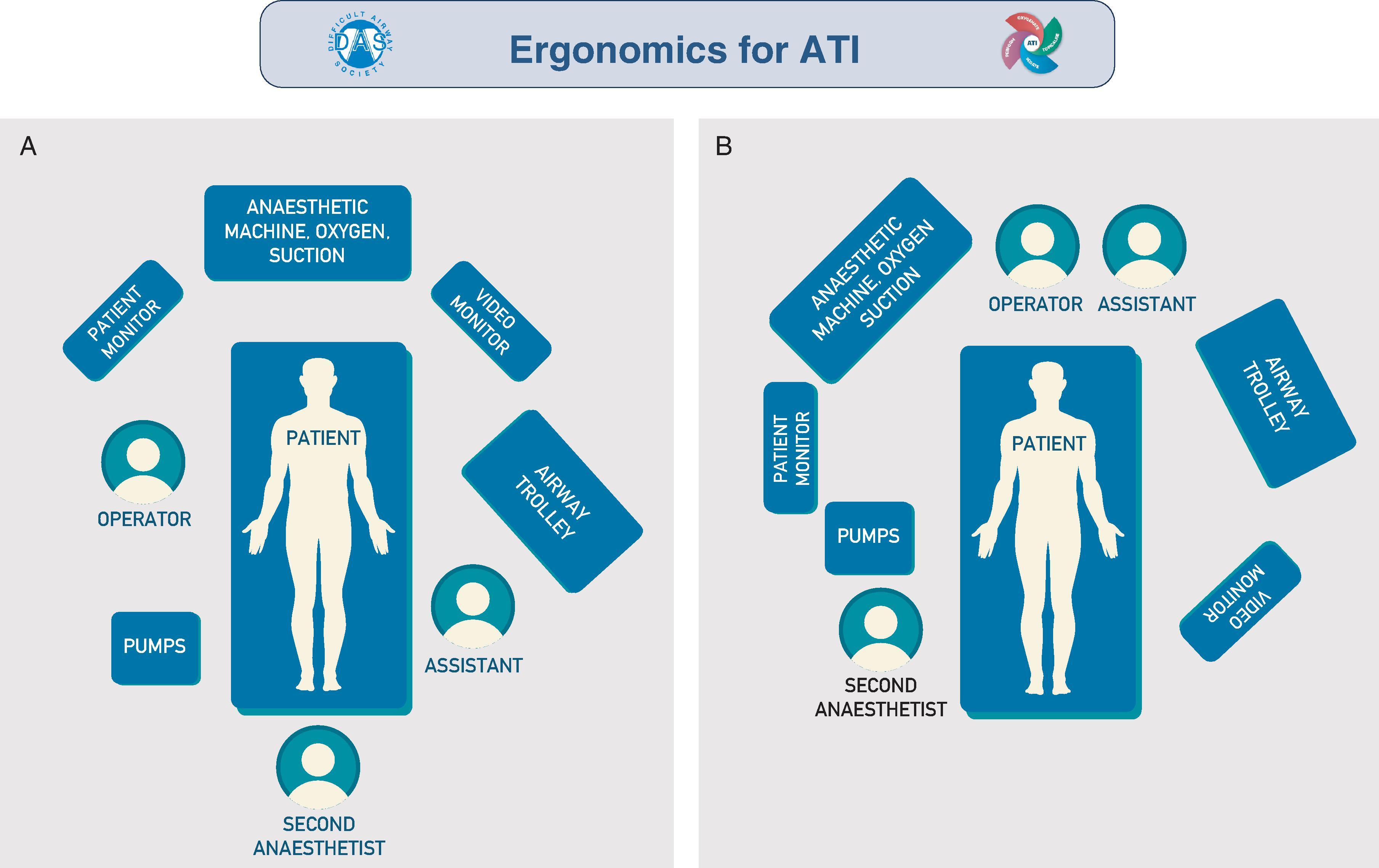
Unless emergency circumstances dictate otherwise, minimum standard equipment should include a DA cart; an oxygen delivery system; suctions; patient monitors; resuscitation equipment; drugs (for topicalization, sedation, GA, reversal agents, and emergency drugs); and drug delivery systems (e.g., target-controlled infusion devices). Equipment for primary and alternative airway management strategies should also be discussed, available, and checked.
Monitoring physiological parameters reduces risks and alerts operators regarding impending complications. Frequently occurring complications that may be avoidable during ATI that may be detected by monitoring are airway obstruction and hypoventilation, which may arise due to oversedation. Thus continuous pulse oximetry should be utilized as a standard. End-tidal carbon dioxide pressure (P etco 2 ) monitoring may be beneficial with alarm parameters set for P etco 2 and respiratory rate. There have been modifications to existing devices that can be used to attach one end of the CO 2 analyzer line from the nasal cannula to the circle breathing circuit, minimizing the burden of disconnecting sampling lines at crucial times during the ATI process ( Fig. 24.13 ). However, this is dependent on the use of a nasal cannula for oxygenation, which might not be ideal. Attachments to high-flow nasal oxygen (HFNO) devices have now been produced, are affordable, and are simple to use, and they may provide an opportunity to undertake continuous waveform capnography in this setting ( Fig. 24.15 ). Regardless of the strategies employed, monitoring for respiratory depression is important during the process of ATI.

Cardiac dysrhythmias or hypotension may occur after the administration of sedation or topicalization agents, and therefore noninvasive blood pressure monitoring cycling frequently (if invasive blood pressure monitoring is not used for separate clinical indications) is mandatory during the performance of ATI.
The use of depth of anesthesia monitors, such as the bispectral index, may be beneficial to monitor sedative drug administration. This may reduce the risk of oversedation, which is known to be one of the most frequently occurring complications during ATI. The benefits of the use of the bispectral index must be weighed against the risks of increasing cognitive load on airway operators.
The supplementary administration of oxygen during ATI should now be seen as mandatory, regardless of the technique selected. Supplemental oxygenation can involve single or combined modes. These include nasal cannula (12–15 L/min), oral cannula, NPA, mask, mask plus CPAP (oral or nasal), jet ventilation, percutaneous transtracheal oxygen therapy (TTO)—with a separate oxygen supply (usually preexisting for oxygen-dependent patients), or HFNO (Fisher & Paykel Healthcare, Auckland, New Zealand) ( Fig. 24.16 ) ( ). Low-flow (≤30 L/min) techniques are associated with a greater risk of desaturation than high-flow techniques, and with the increasing availability of HFNO, this is rapidly becoming the technique of choice. Along with delivering oxygen, HFNO has also been shown to provide some carbon dioxide clearance as well, particularly in the apneic patient, where the technique is known as transnasal, humidified, rapid-insufflation ventilatory exchange (THRIVE). In addition, HFNO may provide flow-dependent CPAP, open soft-tissue passages, reduce dry gas mucosal damage and discomfort, and assist in the dispersion of local anesthetic. Regardless of the oxygen strategy implemented, it should be commenced as soon as possible once patients attend the OR.
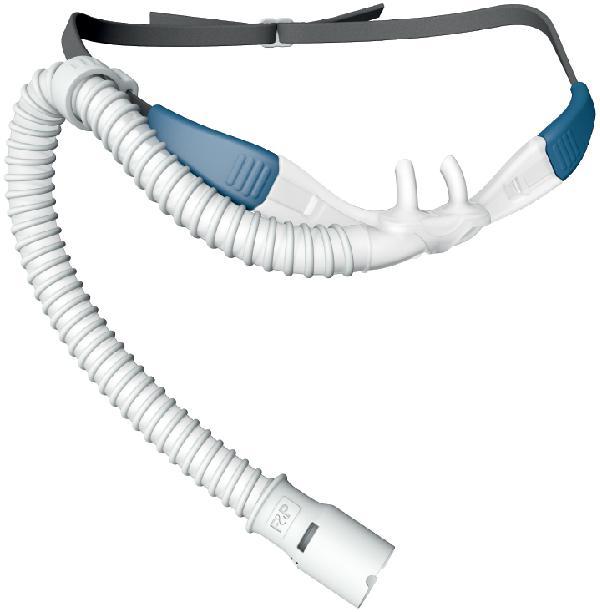
Oxygen insufflation at 3 to 5 L/min via the working channel in adults during ATI was previously proposed to stave off hypoxia, help clear secretions, and prevent fogging. , , Benumof described this technique and recommended it be used very cautiously. If oxygen flow into a patient exceeds gaseous escape into the atmosphere, serious barotrauma might occur, especially with airway narrowing or laryngospasm. Pneumothorax has been reported in pediatric patients with oxygen at excessive adult flow rates. , Acute cervical, facial, and thoracic emphysema were reported in a patient. Documented gastric rupture with subsequent mortality most likely occurred from an FIS directed into an unrecognizable region. Ovassapian and Mesnick did not advise its use during intubation. They did use it to assist LA spray in open, known anatomic areas. ,
Topicalization is the delivery of local anesthetic to key structures in the airway with the aim to anesthetize allowing for safe, effective, and comfortable ATI. While it is technically possible to perform ATI without topicalization, this approach is not only strongly discouraged but may also be associated with increased risks, difficulty, and adverse consequences to patient comfort, anxiety, respiratory distress, hemodynamic changes, gagging, coughing, cooperation, aspiration, and other complications (such as bleeding). The success of ATI is dependent on a fully topicalized airway. To achieve this, a fundamental understanding of the innervation of the airway, risks and benefits of different techniques, and pharmacological principles of local anesthetics is required.
Cranial nerve IX, the glossopharyngeal nerve (GPN), supplies sensory innervation to the soft palate, the posterior third of the tongue, the tonsils, and most of the pharyngeal mucosa. , Some fibers also supply the lingual surface of the epiglottis. It controls the afferent component of the gag reflex. Cranial nerve V, the trigeminal, gives sensory supply to the anterior two-thirds of the tongue, but this area rarely needs anesthesia.
Cranial nerve X, the vagus, forms part of the pharyngeal plexus, giving motor function to the soft palate and pharyngeal muscles. Its superior and inferior laryngeal branches carry sensory supply to the laryngopharynx. The superior laryngeal nerve (SLN) has an internal division for sensory supply to the tongue base, vallecula, epiglottis, piriform recesses, supraglottic mucosa, and laryngeal vestibule above the vocal cords. Its external division provides motor control to the adductors/tensors, the cricothyroid muscle, and the cricopharyngeal part of the inferior constrictor of the pharynx.
The inferior branch of the vagus, the recurrent laryngeal nerve, receives sensory input below the vocal cords, including the subglottic mucosa.
Cranial nerve V, the trigeminal, supplies sensation to the anterior half of the NP via its first branch. The second branch of the trigeminal nerve forms part of the sphenopalatine ganglion, innervating some of the anterior, superior, and central regions. , Cranial nerve IX, the GPN, supplies parasympathetic innervation, while the carotid plexus supplies sympathetics. Cranial nerve VIII, the facial nerve, has parasympathetic function and forms part of the sphenopalatine ganglion to assist in the control of nasopharyngeal reflexes.
Relative and perhaps absolute contraindications to techniques include local infection, anatomic abnormalities, lack of patient cooperation, comorbidities such as coagulopathy (injection methods), and documented allergy or cross-sensitivity. Techniques for topicalization could be noninvasive or invasive. Noninvasive techniques are recommended as they carry safety benefits, require less expertise, and are less unpleasant to patients.
These methods may anesthetize everything from the back of the pharynx and posterior tongue to the superficial surface of the vocal cords. In advance, give instructions to the patient about taking deep breaths (rather than coughing out sprays), gargling (to maximize local drug effect), and/or swallowing (to remove LA-mixed saliva before fresh applications).
The simplest and perhaps most effective technique for achieving this is using 10% lidocaine spray to the oropharynx ( Fig. 24.17 ). Each spray delivers 10 mg of lidocaine (0.1 mL), allowing a generous number of sprays before approaching maximum doses. Moreover, the high concentration of local anesthetic affords a rapid onset of topicalization. Operators should spray the tongue, tonsillar pillars, and the base of the tongue (GPN block). Thereafter, asking patients to take a deep breath in while simultaneously spraying will allow the local anesthetic to reach the epiglottis, larynx (SLN block), and trachea. A total of 20–30 sprays should suffice (meaning a dose of 200–300 mg of lidocaine). However, should further LA be required for the larynx and below, using the effective and inexpensive MADgic atomizer (Teleflex Medical, Morrisville, NC, USA) curved to allow careful placement above the glottis with 1–4 mL of lidocaine sprayed and gargled may further contribute to SLN block. This combined technique can often be used as the sole topicalization strategy if delivered appropriately and has been advocated by the Difficult Airway Society (UK).
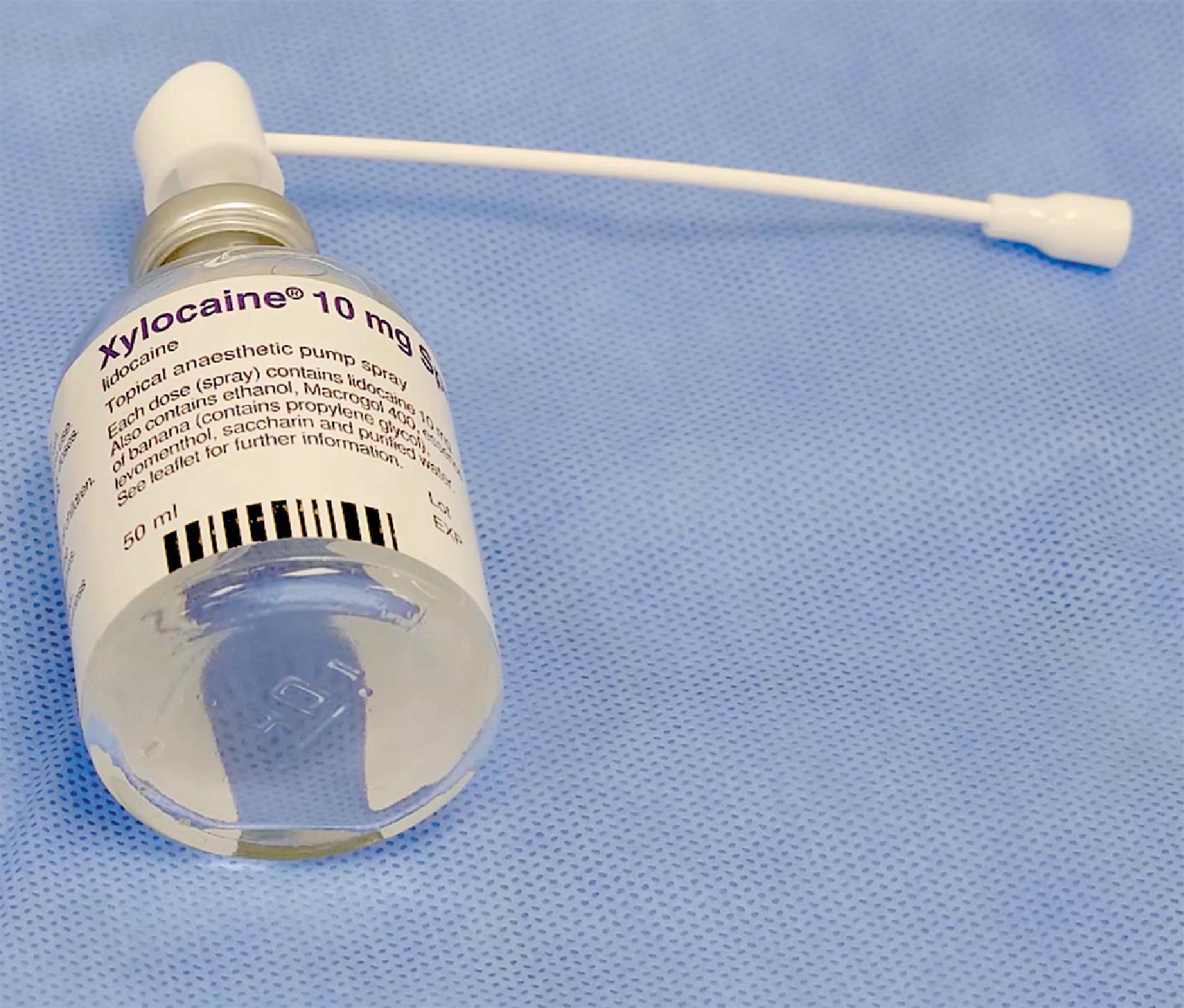
Other approaches include a lollipop method with 3 cm of 2% to 5% lidocaine paste on one end of a tongue depressor, or a direct toothpaste method (gel down the middle of the tongue) ( Fig. 24.18 ), leaving drugs to dissolve over 5 to 10 minutes. Alternatively, let a Tessalon Perles (benzonatate) dissolve in the middle of the tongue (may need to bite it slightly, once).
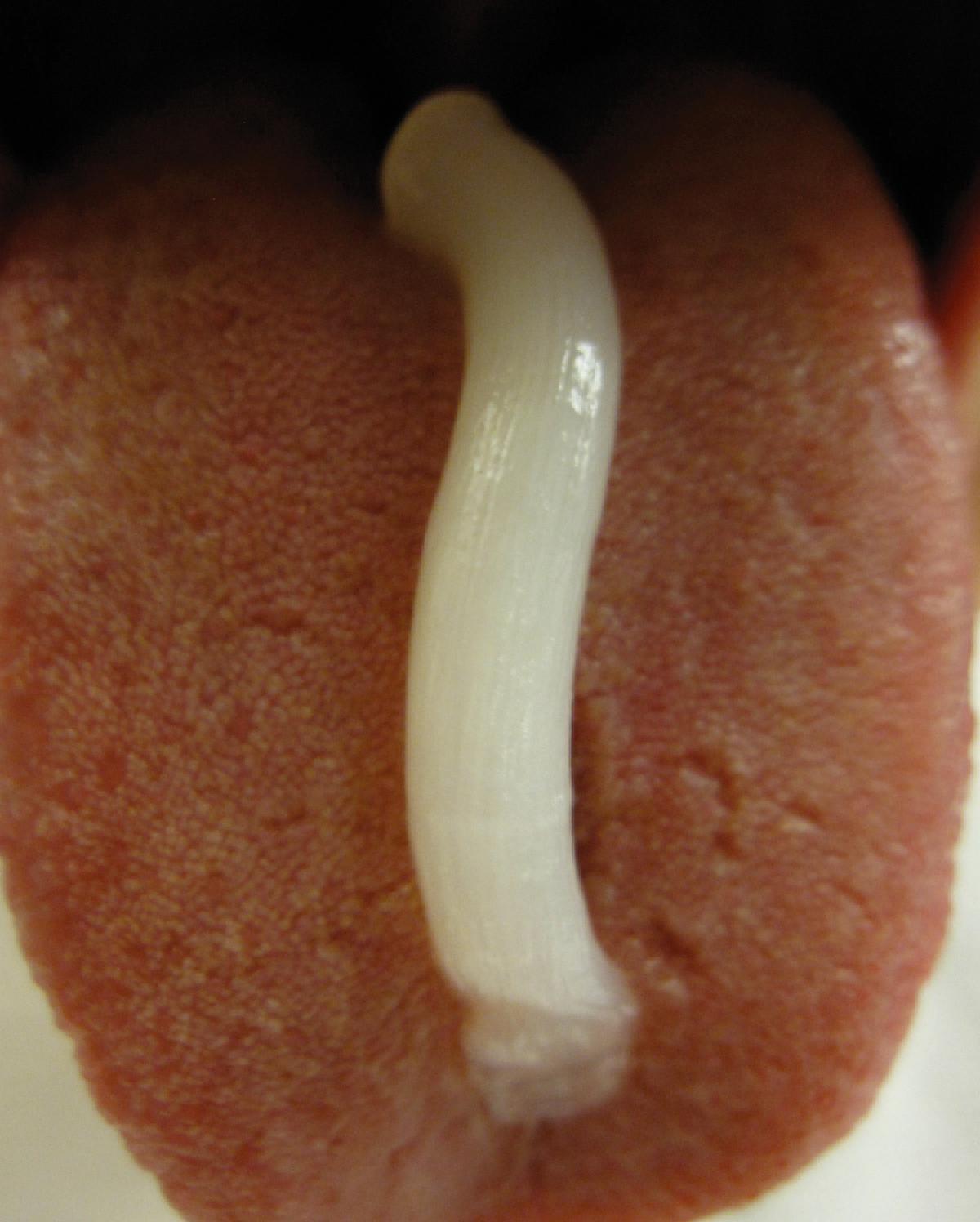
This is an alternative to the simple spraying of local anesthetic described above. The advantage of the aerosol method is that 5 mL of 4% nebulized lidocaine can potentially anesthetize the entire airway without needling or much cooperation if given by mask. If it works, nebulized lidocaine is the best method to avoid coughing during LA administration; however this technique is time consuming, has variable effectiveness, and is associated with variable local anesthetic absorption; thus higher doses are required. ,
This method is for patients with incomplete or no GPN, SLN, and/or transtracheal block(s). Quick pulses of 1 mL of 2% to 4% lidocaine from a syringe attached to the FIS working channel are injected onto areas requiring further LA. It is best to avoid using suction concomitantly as this will lead to reduced local anesthetic dispersion. To avoid obscured movement views from reactions to sprays, attach the syringe to a three-way stopcock on a taped epidural catheter (0.5- to 1-mm diameter; single distal hole) threaded through the suction port until extending 1 to 2 cm beyond the FIS tip ( Fig. 24.19 ). Epidural catheters mimic the effect of small pediatric FIS channel diameters, causing jet-like flows that require smaller 0.2-mL pulses.
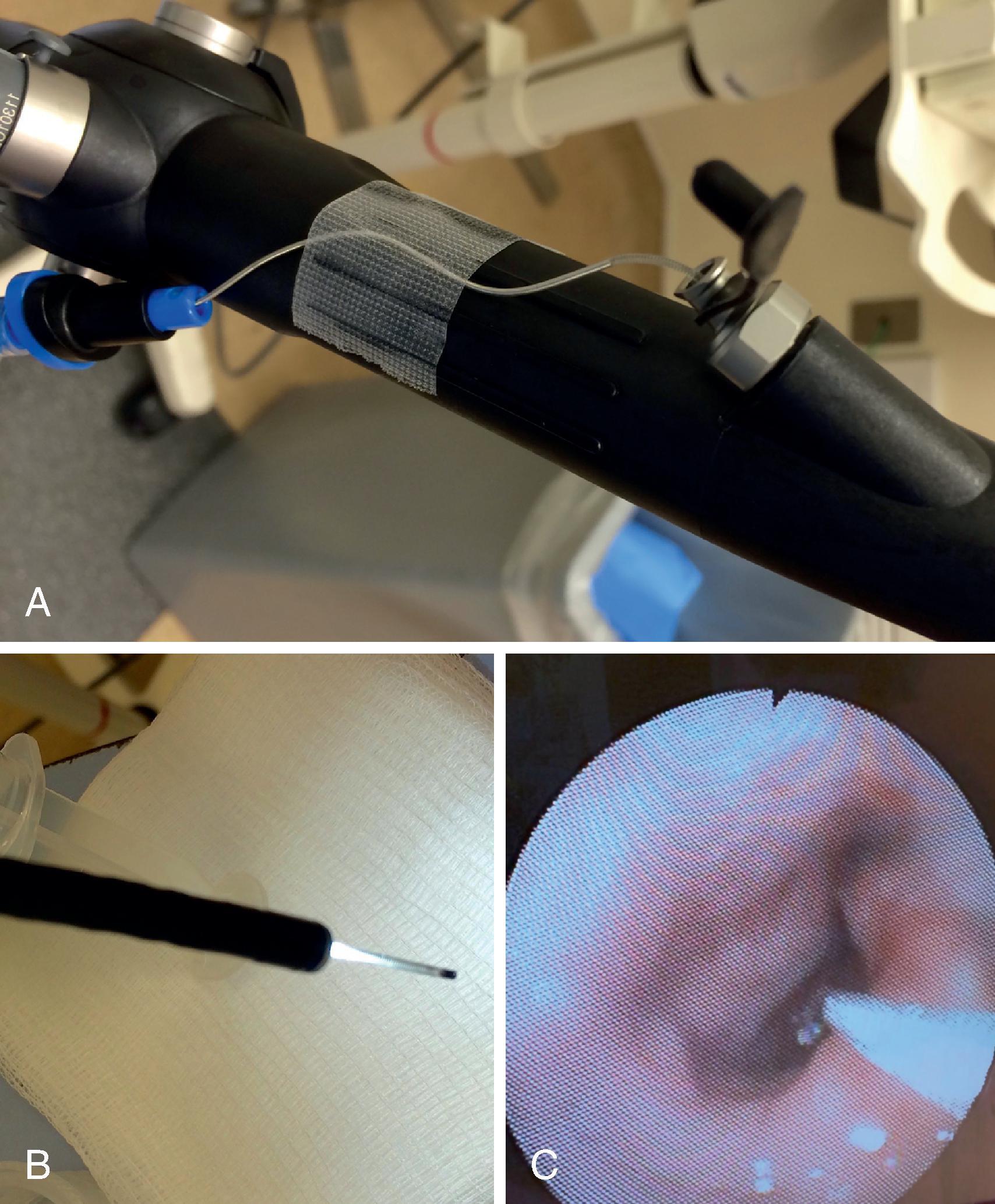
We do not recommend the routine use of invasive approaches to airway topicalization beyond expert hands. This is because they have been associated with higher plasma concentrations of local anesthetic, local anesthetic systemic toxicity, and lower patient comfort, as well as carrying risks of causing hematomas, potentially worsening airway compromise, and increasing the complexity of the entire procedure. Moreover, the effectiveness of minimally invasive techniques means that the necessity for invasive approaches is less apparent. Finally, the use of landmark approaches, while useful, is probably now superseded by ultrasound-guided techniques, allowing the visualization of structures of interest that one hopes to either access or avoid. However, it is useful for readers to have a full understanding of the benefits and landmark-guided techniques of invasive approaches.
The SLN approach is particularly advantageous if intraoral chances of success are less, including in patient situations with no oral cavity entry and that only permit a few quick peritonsillar sprays (e.g., limited cooperation); to rescue failed gel, spray, aerosol, or nebulized internal SLN block; if coughing or hemodynamic changes from FIS “spray as you go” are inadvisable; or to prevent severe laryngospasm episodes that might have been experienced previously with intraoral LA.
The easiest technique is with 6 mL of 1% lidocaine in a 10-mL syringe attached to a 21- or 22-gauge needle as an injection system while aiming for a hyoid cornu ( Fig. 24.20 ). After the needle tip hits the bone, shift the nondominant hand to brace the system at the hub against the neck. Aspirate gently. If no blood returns, inject 3 mL slowly. Repeat on the other side. Constant aspiration and bracing are vital and easily avoid intravascular injection (especially intracarotid), similar to regional blocks (e.g., interscalene). This approach has a lower incidence of complications, such as laryngospasm or gagging, compared with topical LA techniques.
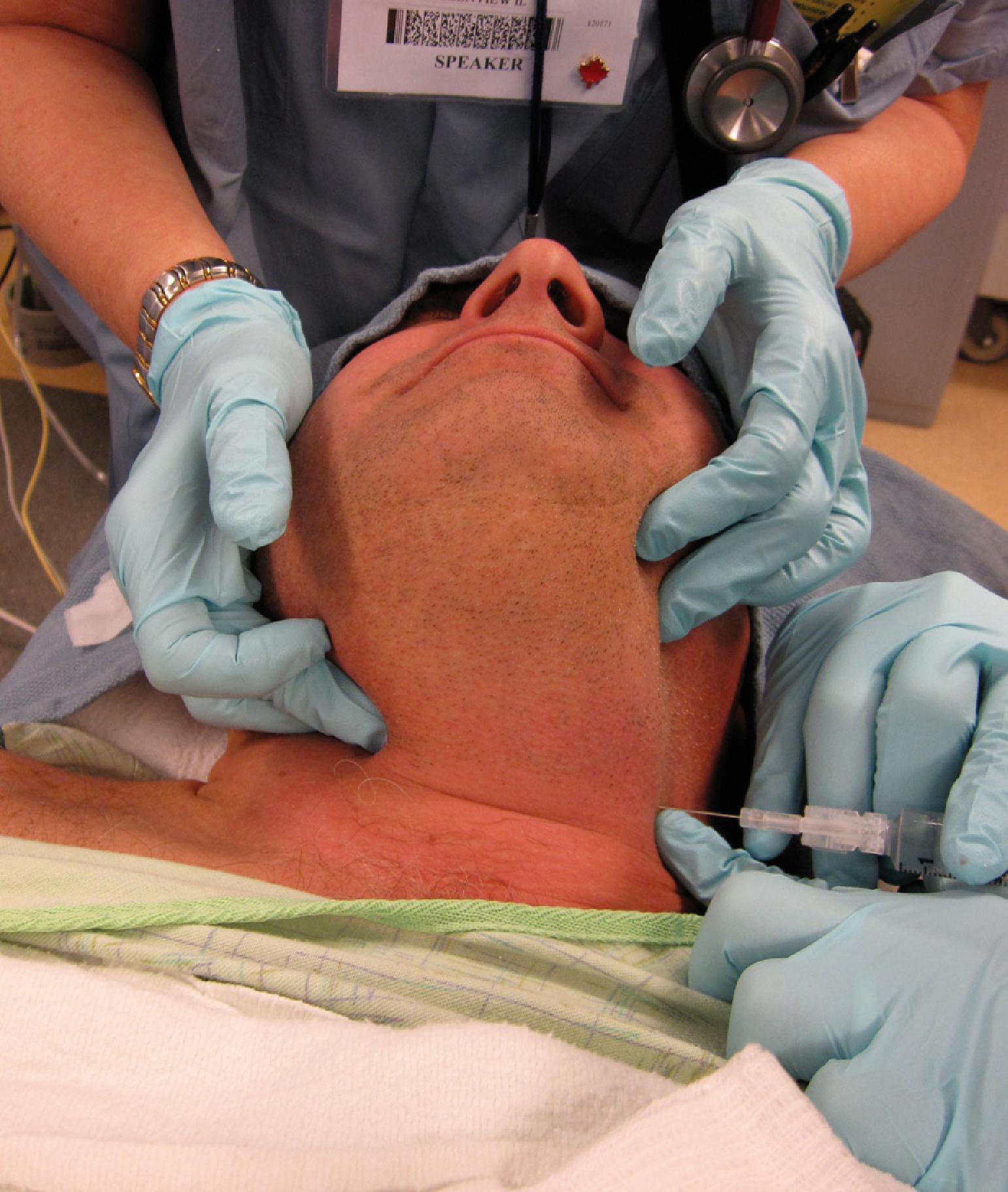
An uncommon intraoral SLN block method involves putting pressure in the piriform fossa with a lidocaine-soaked gauze on a forceps, requiring up to 20 minutes to take effect.
Of all the invasive topicalization techniques, this is probably the most. Of course, transtracheal blocks (TTBs) provide excellent intratracheal anesthesia. However, other benefits include developing expertise in locating the cricothyroid membrane (CTM) by manual assessment (an immediate test for accuracy is the aspiration of many bubbles) or ultrasound (which is more accurate than manual palpation alone ( Fig. 24.21 ). ,
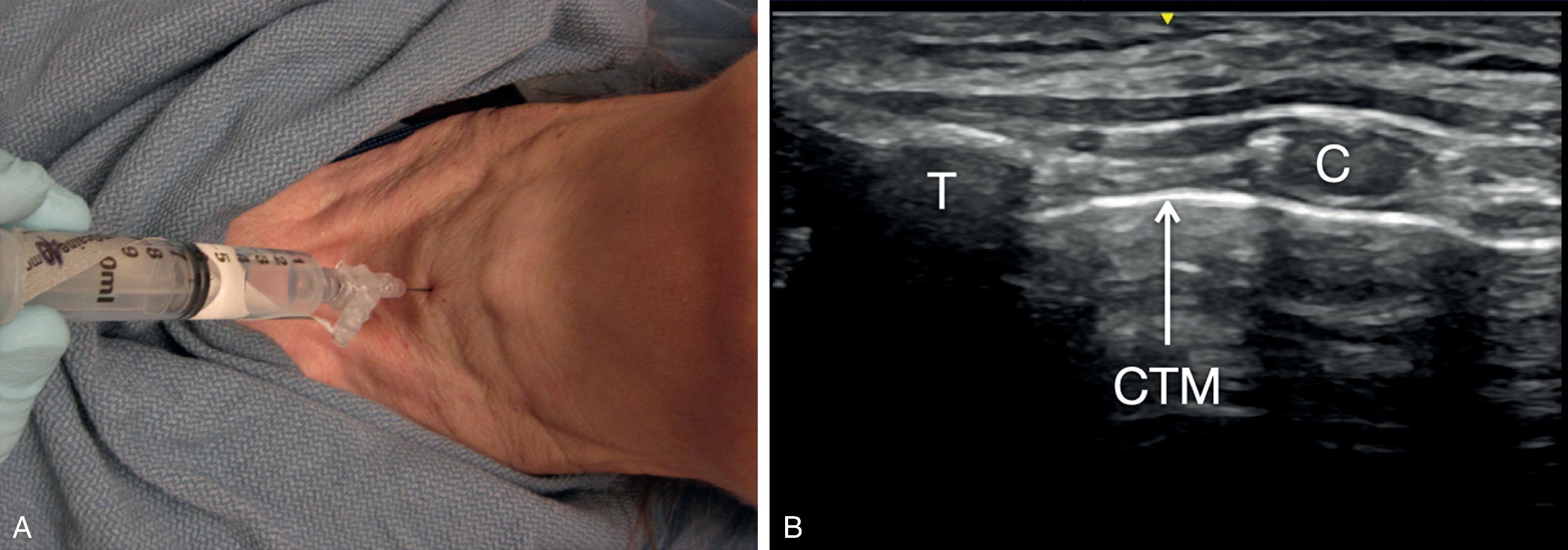
This skill extends to emergency cricothyrotomy situations, with potential life-saving benefits. Poor ability to detect the CTM was evident in the 4th National Audit Project (NAP4), which reported a 43% to 64% cricothyrotomy failure rate in emergencies. Before this, Elliott and colleagues demonstrated that accurate CTM assessment by the equivalent of experienced residents and attending faculty was only 30%, with poorer estimates mostly dependent on female gender or obesity. Aslani and colleagues later pointed out that 46 of 56 female patients had an incorrect evaluation of the CTM up to 1.6 cm laterally, 2.5 cm superiorly, and 4 cm inferiorly. One in 16 obese patients had correct identification. These results indicate that, as frequently as possible, clinicians should be encouraged to perform TTBs. The use of ultrasound is a significant advancement in this setting, and success rates have increased substantially with the assistance of this imaging modality. ,
Tips for TTB success include the following: with two hands, aspirate gently with a posterior aim to enter the CTM, to avoid vocal cords; keep aspirating air until after maximal patient exhalation, brace, and continuously inject. It causes a minimal cough, followed by a huge breath that spreads the LA and more coughing. Needle technique advantages: (1) is faster than an angiocatheter method; (2) has fewer steps; (3) is less likely to provoke coughing or injury caused by hitting the posterior tracheal wall while threading the catheter (some like to fully thread it like an IV); and (4) is more successful (needles are shorter, less flexible, and, even if pulled out of the trachea, can be advanced easily). Using a needle rather than an angiocatheter is advocated by various authors.
Is coughing during TTB a problem in cervical spine–risk patients? According to Todd and Crosby, the answer is no. They advise that concern about TTB is unfounded; because of those who coughed, none has ever been shown to develop secondary neurologic damage.
Which technique(s) is/are best? With regard to the occurrence of coughing during FIS insertion, in comparison studies between TTB and “spray as you go,” patients in the TTB group reacted far less, according to Webb and colleagues. Gupta and colleagues demonstrated a better result with TTB as well, when comparing it with nebulized LA. This study was associated with much less gagging and laryngospasm in the TTB group, even though a lidocaine gargle had been used for everyone. Others have also found that a combination translaryngeal, SLN, and GPN block was better than nebulization, with fewer reactions, less grimacing, or fewer hemodynamic changes. , El-Boghdadly et al. demonstrated that the use of a spray-only technique in conjunction with MADgic glottic spraying is associated with a high success rate and low complication rate. It is therefore our opinion, as well as that of the Difficult Airway Society, that this noninvasive approach should be the most widely practiced, with more advanced techniques reserved for specialist hands ( ).
The route for tracheal intubation should factor in patient anatomy, surgical access, and extubation plan. For example, in patients with limited mouth opening the nasal approach may be the only option, while in patients having nasal surgery, the oral approach may be the preferred route. There is also no evidence favoring the superiority of the oral route when compared with a nasal route, or vice versa. , Therefore the nasal approach remains an invaluable route for tracheal intubation that readers should be familiar with.
Topicalization involves the administration of both a local anesthetic agent to render the nasopharynx (NP), posterior pharyngeal wall, and periglottic area insensate and a vasoconstrictor to reduce the risk of bleeding and maximize the caliber of the NP. Oropharyngeal topicalization is still required to ensure the larynx and trachea are also anesthetized. This is most easily achieved with the use of co-phenylcaine spray, which is composed of 2.5-mL lidocaine 5% with phenylephrine 0.5%. This can be delivered using a nasal mucosal atomizing device ( Fig. 24.22 ). First, one should select the nasal passage with the greatest luminal size by asking the patient to sniff through each nare; the one with the least subjective restriction to inspiration should be used in the first instance unless otherwise indicated. Regardless of luminal caliber, when topicalizing, apply them to both nasal passages to avoid delays in having to anesthetize the other side if the first is too small. Then co-phenylcaine is sprayed synchronously to a deep “sniff” by the patient to ensure appropriate dispersion. It is usual for patients to experience a “trickle” of the local anesthetic spray in the back of their throat. This approach is simple, rapid, and well tolerated by patients.
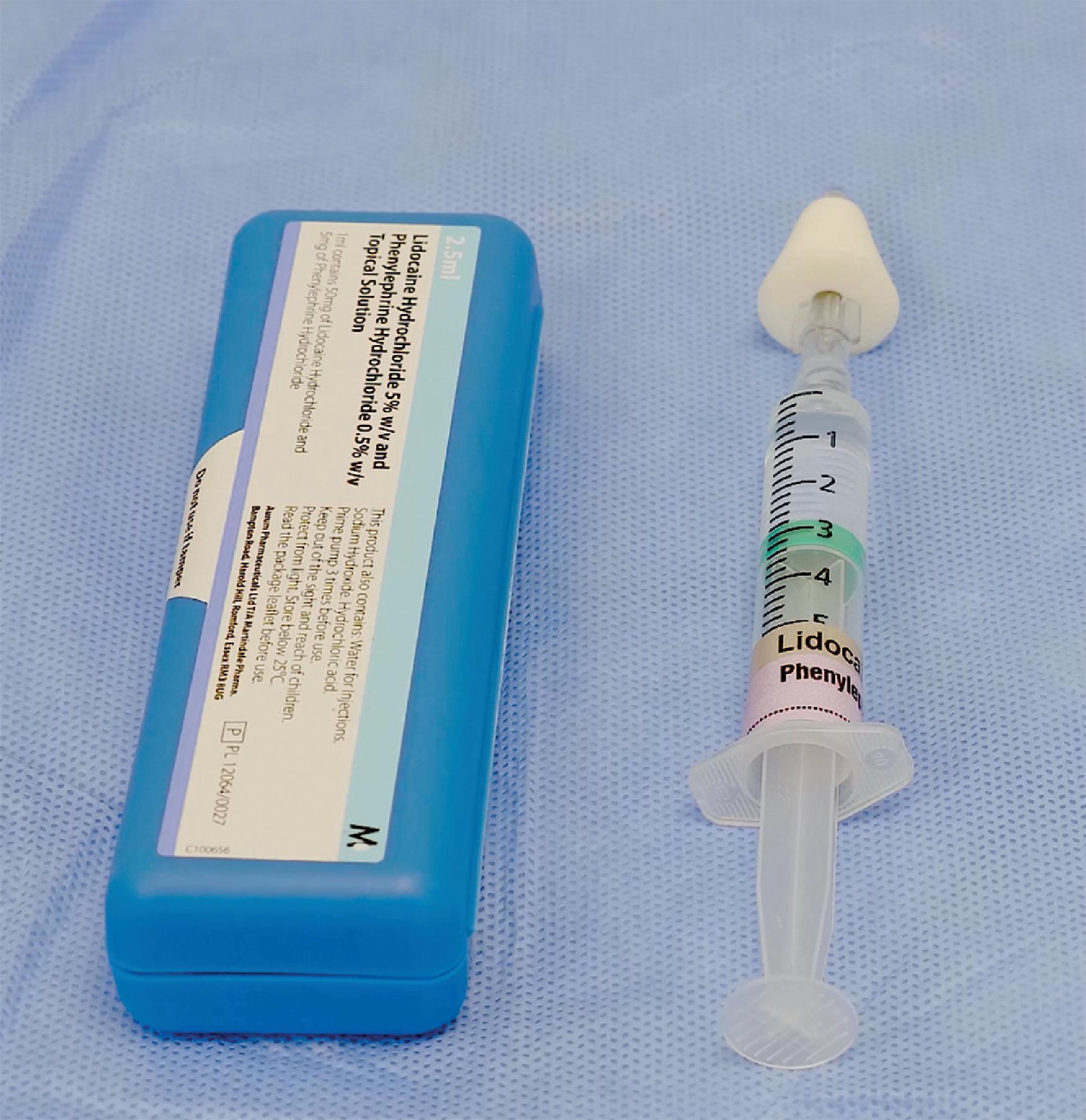
There are alternative approaches to nasopharyngeal topicalization. For example, one may use two Q-tips per nostril dipped in either phenylephrine, in oxymetazoline mixed with lidocaine, or in plain cocaine. Apply every single swab in succession to the outermost part within the nostril, using a fingertip on the stick end to gently push inward perpendicularly to the facial plane until feeling slight resistance ( ). By the fourth Q-tip, vasoconstriction onset will allow sequential pushing farther in with each in a similar fashion until a point of no resistance posteriorly. This facilitates gauging the NP caliber for ETT passage. Midway through the process, pulse in 0.2 mL of solution with a 20-gauge angiocatheter (needle removed) in each of three different directions per nostril to minimize trauma. This uses a total of 2 mL of solution (e.g., 80 mg of 4% cocaine). It is notable that the use of cocaine for this purpose is reducing given that it is associated with cardiovascular complications and does not lead to a superior effect when compared with phenylephrine or oxymetazoline.
Alternative techniques involve using NPAs coated in lidocaine gel and phenylephrine. Some suggest that inserting progressively larger NPAs can mechanically dilate the NP passage. However, Adamson and colleagues reported that this method only caused increased trauma, hemorrhage, and delay of intubation, and therefore this practice should be avoided.
LA dosing for various airway blocks is listed in Table 24.2 . It is not recommended to use LA brands containing benzocaine because of methemoglobinemia risk (Hurricaine, Exactacain). Although methemoglobinemia instances were much more frequently reported in patients undergoing transesophageal echocardiography, some occurred among FSI-managed patients after unlimited, continuous spraying. Lidocaine is the most commonly used LA for topicalization in this setting and is associated with a safer and more predictable cardiovascular and systemic toxicity risk profile. The dose of topical lidocaine should not exceed 9 mg/kg lean body weight, as higher doses are associated with a significantly increased risk of toxicity. The total dose of all local anesthetics delivered, regardless of the route (e.g., regional anesthesia or surgical infiltration), must also be considered. In terms of selecting the appropriate concentrations of local anesthetic to use there has been some evidence that lower concentrations of lidocaine are as effective as higher concentrations, but higher concentrations may be associated with more rapid onset of airway anesthesia. A high index of suspicion of the rare possibility of local anesthetic systemic toxicity should be in place ( Box 24.4 ).
| Drug | Form | Appropriate Blocks |
|---|---|---|
| Lidocaine | Pacey’s paste (slurry): 7 mL 2% solution + 7 mL 2% viscous in two syringes with 3 mL air each + sweetener (mix back and forth via three-way stopcock); should be swished intraorally in 2 aliquots | |
| 2%–4% solution | All blocks except as listed below | |
| 1% solution | Preferred for SLN neck blocks | |
| 4% solution | Preferred for transtracheal blocks | |
| 2% viscous lidocaine | Intraoral or nasopharyngeal | |
| 2%–5% gel/ointment/paste | Intraoral | |
| Tessalon Perle (benzonatate) | 200-mg capsule | Intraoral |
Vasoconstriction
Phenylephrine 0.5% spray
Oxymetazoline 0.05% spray
Local anesthesia
Lidocaine 2%–4% spray, gel, viscous, paste
Both vasoconstriction and local anesthesia
Cocaine 4% with a maximum dose of 1.5 mg/kg104
Mixture of 2%–4% lidocaine (3 mL) + 0.5% phenylephrine (1 mL) or 0.05% oxymetazoline (1 mL)
ATI may be safely and effectively performed without sedation. , However, its use may reduce patient anxiety and discomfort and increase procedural tolerance. Sedatives have both desirable (e.g., amnesia) and detrimental effects (e.g., oversedation), and the risks of the latter may lead to respiratory depression, airway loss, hypoxia, aspiration, and cardiovascular instability. It could therefore be beneficial to have an independent anesthesiologist delivering, monitoring, and titrating sedation. Targeting a Ramsay sedation scale level 3 or 4 is ideal ( Box 24.5 ). A single-sedative strategy is likely to be the safest approach, but if multiple agents are used, this is further reason to have an independent practitioner taking responsibility for safe sedation.
Patient is anxious and agitated, restless, or both.
Patient is cooperative, oriented, and tranquil.
Patient responds to commands only.
Patient exhibits brisk response to light glabellar tap or loud auditory stimulus.
Patient exhibits a sluggish response to light glabellar tap or loud auditory stimulus.
Patient exhibits no response.
The choice of appropriate sedative drugs is critical. Remifentanil and dexmedetomidine are associated with high levels of patient satisfaction and low risk of oversedation and airway obstruction when used for ATI. Dexmedetomidine provides sedation, analgesia, hemodynamic stability, antisialagogue effects, and amnesia. It is administered as a 0.7- to 1.0-µg/kg bolus over 10 minutes, followed by a 0.5- to 1.0-µg/kg/h infusion. Remifentanil provides analgesia and antitussive effects and is administered as a 0.05- to 0.1-µg/kg bolus followed by a 0.03- to 0.1-µg/kg/min infusion. Alternatively, a target-controlled infusion of 1–3 ng/mL using a Minto model may be used.
Propofol is associated with a significant risk of respiratory depression and unresponsiveness, with there being a fine line between nonsedative effects and respiratory depression. More precisely titrated sedation may be administered with target-controlled infusions. Propofol and remifentanil have been studied most extensively. Mean target plasma concentrations for propofol and remifentanil were 1.3 µg/mL (standard deviation, 0.2 µg/mL) and 3.2 ng/mL (SD, 0.2 ng/mL), respectively. Rai and colleagues found no difference in patient satisfaction between the two while noting better ATI conditions and a higher recall incidence with remifentanil than with propofol. Similar results were reported by Cafiero and colleagues. Surprisingly, with remifentanil alone, up to 100% of patients had a recall of events, usually not perceived as unpleasant. In cervical trauma patients a remifentanil effect site concentration as low as 0.8 ng/mL was effective for ATI. Very short induction and recovery times with remifentanil may represent a major advantage. Possibilities of increased thoracic wall rigidity and laryngospasm should be kept in mind.
Other sedatives may be used but are associated with inferior safety and efficacy when compared with dexmedetomidine and remifentanil ( Table 24.3 ).
| Drug | Dose | Effects |
|---|---|---|
| Midazolam | 0.015- to 0.03-mg/kg boluses | Amnesia/sedation |
| Fentanyl | 0.7- to 1.5-µg/kg boluses | Analgesia/antitussive |
| Ketamine | 0.07- to 0.15-mg/kg boluses | Sedation/analgesia |
| Remifentanil | 0.05- to 0.1-µg/kg bolus; 0.03- to 0.1-µg/kg/min infusion Or TCI 1–3 ng/mL |
Analgesia/antitussive |
| Dexmedetomidine | 0.7- to 1.0-µg/kg bolus over 10 min, followed by 0.5- to 1.0-µg/kg/h infusion | Sedation/analgesia/hemodynamic stability/antisialagogue/amnesia |
| Propofol | 25- to 75-µg/kg bolus; 25- to 75-µg/kg/min infusion | Sedation |
Antisialagogues have traditionally been used to reduce secretions to improve FIS views, dilute LA, and reduce the risk of laryngospasm. However, their use is not mandatory in ATI as they may be associated with undesirable clinical consequences and must be administered well in advance of the ATI ( Table 24.4 ).
| Drug | Onset | Duration of Action | Terminal Elimination Half-life | Dosing | Notes |
|---|---|---|---|---|---|
| Glycopyrrolate | 20 min (IM) | 30–60 min | 40–80 min | 0.2–0.4 mg | Administer 30–60 min preprocedure |
| 3–5 min (IV) | 30–60 min | 40–80 min | 0.1–0.2 mg | May produce significant tachycardia | |
| Atropine | 20 min (IM) | 30–60 min | 2 h | 0.3–0.6 mg | Administer 30–60 min preprocedure—less commonly used than glycopyrronium bromide due to tachycardia |
| 2–3 min (IV) | 30–60 min | 2 h | 0.2–0.3 mg | May produce significant tachycardia | |
| Hyoscine | 30 min (IM) 5–10 min (IV) |
4 h | 5 h | 0.2–0.6 mg | Administer 30–60 min preprocedure Longer-lasting systemic effects than glycopyrrolate and atropine May produce tachycardia, dizziness, and sedation |
Preparation for ATI should follow sequentially, while adjustments are made according to individual concerns (see Box 24.6 ). The use of a checklist is beneficial ( Fig. 24.23 ), and constant communication with patients is mandatory. After timely antisialagogue administration (if used), early application of oxygen, and administration of LA with or without sedatives, move the bed/table to its lowest setting, if supine. If ATI is performed facing the patient, sit the patient upright while elevating the legs slightly to reduce the risk of the patient drifting down the bed. Ramping patients with blankets is possible but not ideal ( Fig. 24.24 ). A step stool may be useful to keep the FIS straight and reduce strain on the operator’s arms.
Check FIS equipment.
Choose FIS diameter closest in size to ETT diameter (keep lubricant available).
Attach to electricity and light source, adjusting according to FIS instructions.
Test FIS lever, tip motion, clarity, and focus by looking at nearby printed object.
Choose ETT size at least one-half size smaller if a difficult airway is present.
Use defogger as needed and insert FIS and ETT into warm irrigation bottle.
Interview and examine patient; discuss the plan (psychological preparation).
Administer antisialagogue at least 15 minutes before giving topical oral LA.
Administer sedative intravenously if not contraindicated, and possibly LA.
Administer sodium citrate if small aspiration risk is present.
If patient is going to the operating room, on arrival, place monitors.
Administer oxygen by cannula, unless patient is healthy and listening to Sp o 2 preferred.
Start or finish LA administration, and titrate sedatives/opioids as indicated.
Position the patient: if supine, lower the bed maximally. If sitting, locate equipment where optimal, keeping in mind that some FISs have adjustable arrow indicators.
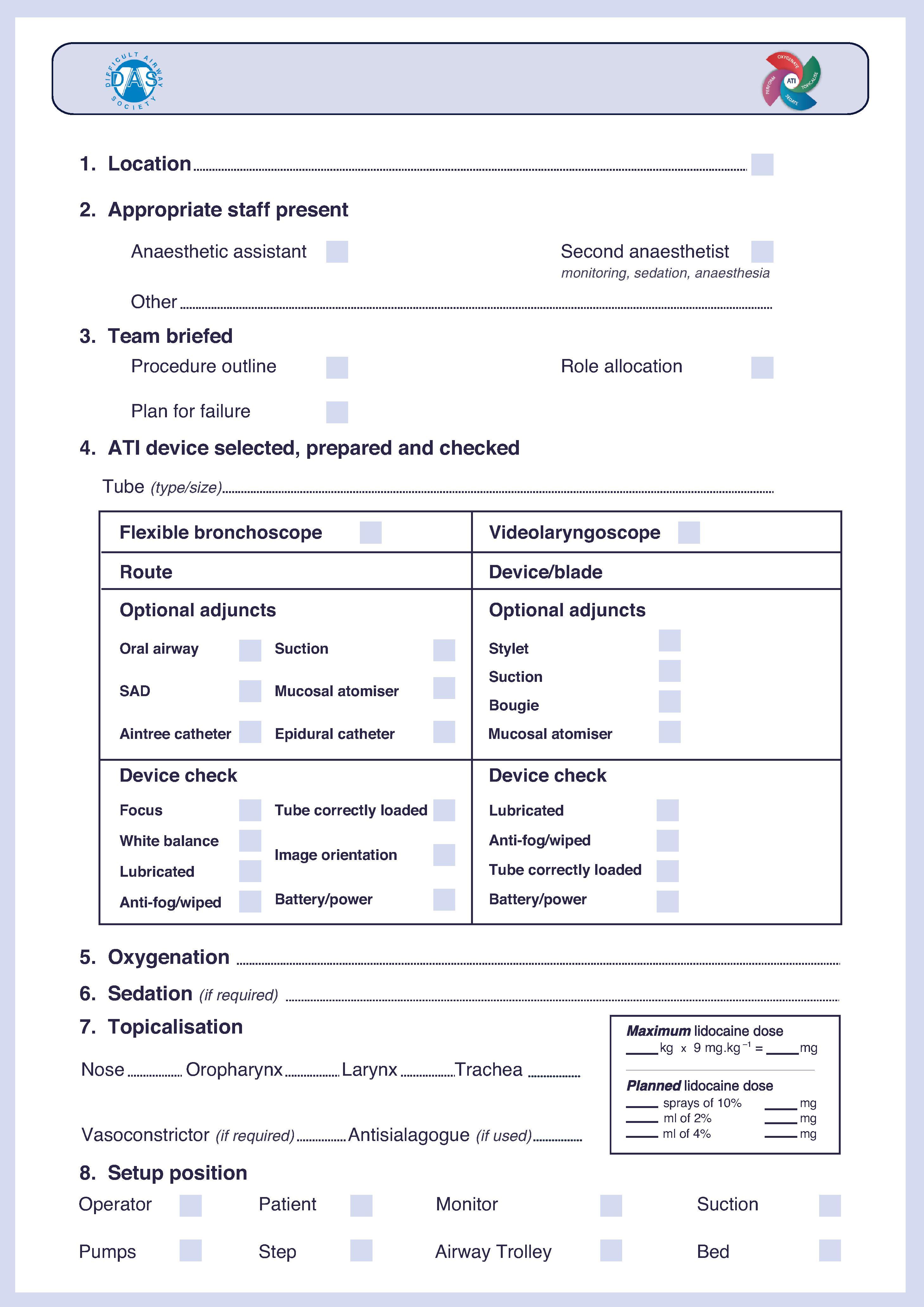
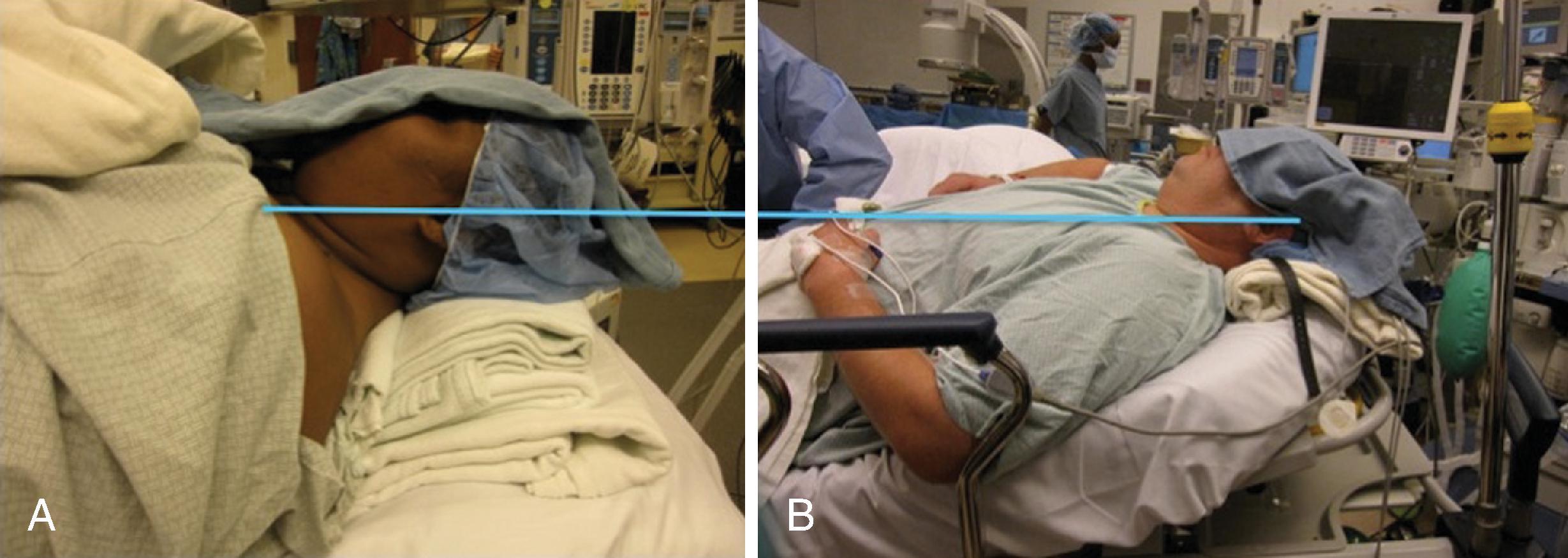
Throughout the process, operators must constantly think about optimizing the key elements of ATI: oxygenation, topicalization, sedation, and procedural performance. Oxygen should be up-titrated throughout the procedure, and if using HFNO, this should increase to 60 L/min. Careful, accurate, and dose-calculated LA should be administered without rush while appropriate and titrated sedation delivered simultaneously, if used. Once the planned topicalization strategy is complete, the sensation of the oropharynx should be tested with a Yankauer sucker, which would also simultaneously clear secretions. A wide-bore soft suction catheter may be advanced in the midline through the oropharynx and then further advanced into the trachea by asking the patient to inspire while advancing the catheter. This will allow both the assessment of the extent of topicalization and suctioning secretions. If the patient gags, GPN anesthesia is lacking, whereas if coughing occurs, SLN anesthesia is inadequate, presenting a good opportunity to apply further LA.
For an oral route, the patient can be asked to open their mouth and protrude their tongue, after which a bronchoscope airway (VBM Medical Inc., Noblesville, IN) or a Berman IOA can be inserted in the midline. If the patient is unable to protrude their tongue, an assistant can grasp the anterior and posterior surfaces of the tongue with gauze to gently pull it outward but not tear the frenulum linguae. This often lifts the tongue off the palate and elevates the epiglottis ( Fig. 24.25 ).
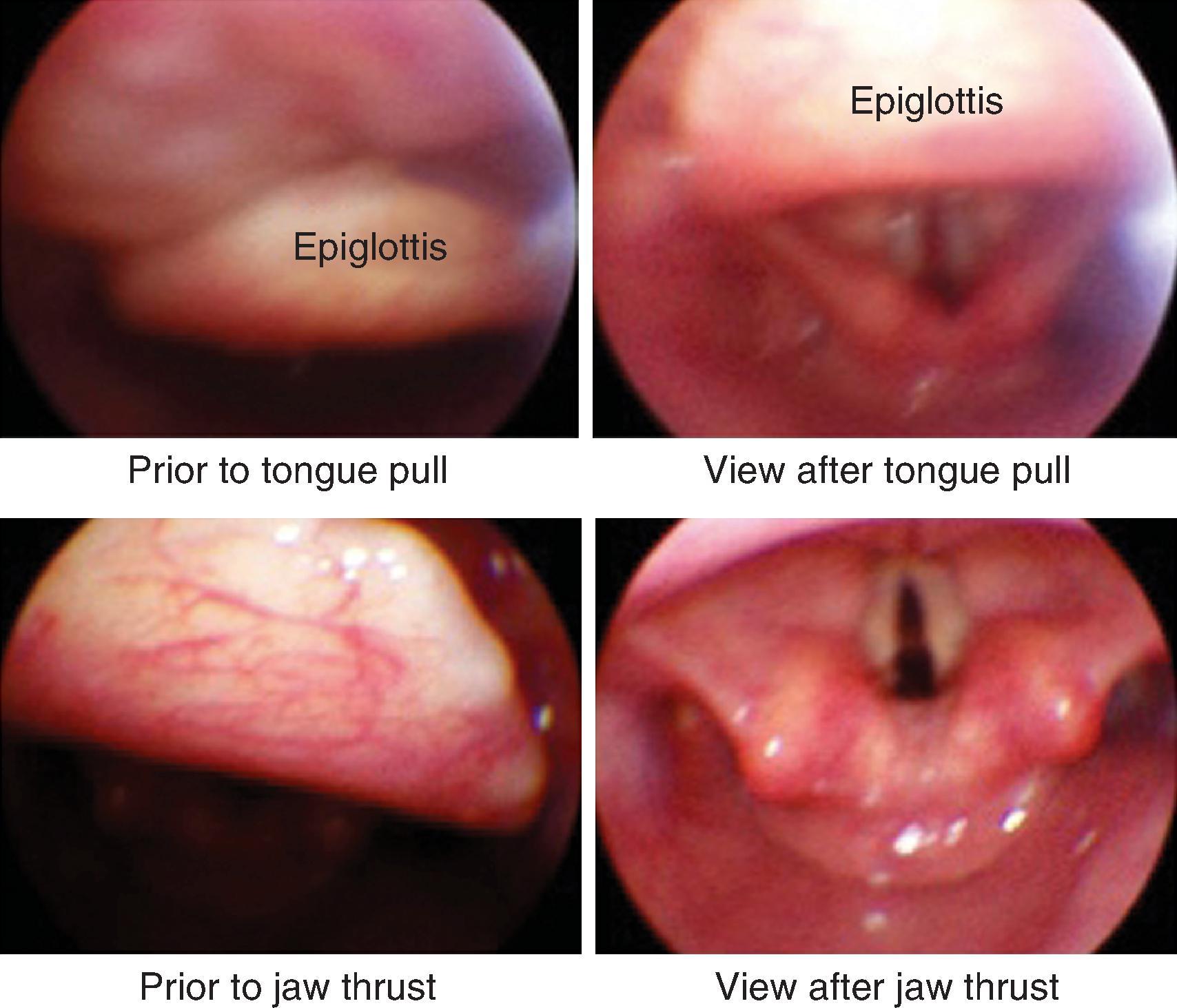
Many experts recommend holding the FIS handle with a nondominant hand, because thumb pressures on the lever and forefinger depression of the suction valve are not as intricate movements as directing the bronchoscope tip with the dominant hand. To prevent the ETT from sliding down, gently snug it fully up the bronchoscope, tape it in place with the connecter, or use an ETT-holding element if the bronchoscope has one ( Fig. 24.26 ). Before you begin, gently warm the tip of the bronchoscope on the patient’s tongue to reduce the risk of misting, then ensure the tip is wiped clean. Control the bronchoscope as it advances through the mouth, keeping it midline with the dominant hand’s thumb and first two fingers, similar to a pen. Brace the fourth and fifth fingers on the IOA, lip, or cheek to avoid tremulous motion and eye injuries.
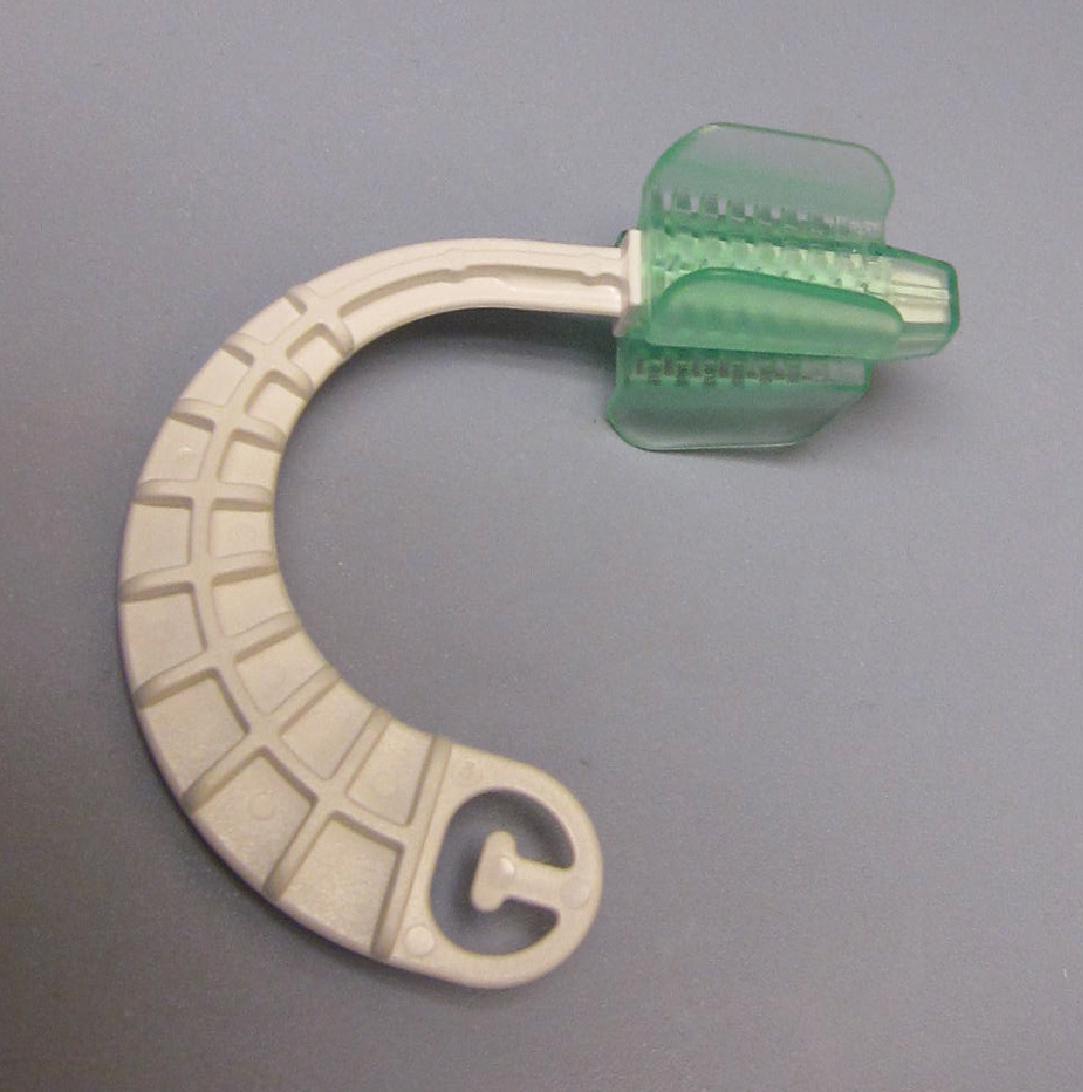
To reduce endoscopist fatigue, employ a gentle curve in the bronchoscopy by bending the handle control arm’s elbow very near to one’s anterolateral rib cage so that the handle hand is relaxed by the shoulder unless the arm-straight-out style is preferred.
Insert the bronchoscope into the patient’s mouth, down the IOA, while keeping the demarcation between IOA and mucosa colors in the center of view. Use the lever to look up or down while turning the bronchoscope (using both hands in unison) to look left or right; always keeping known anatomy in the center. Go around obstacles, such as secretions, or suction them. Slowly insert the bronchoscope perpendicularly toward the pharynx 6 to 8 cm, past the palate and the uvula, and move the lever to look for the epiglottis and glottis. Jaw thrust or asking the patient to phonate and protrude their tongue often helps lift the epiglottis. , For severely limited mouth opening, retromolar entry is often possible. Then consider the three successive directions.
Airway specialists are familiar with the upper airway configuration, as routinely observed with a laryngoscope. On the other hand, the different axes successively followed plus the structures involved during bronchoscopic intubation and their reciprocal spatial organization are less emphasized in classic teaching programs. Moreover, many medical textbook sketches or drawings are inaccurate, depicting the upper airways as a regularly curved line joining the oropharynx or NP to the carina. This is misleading, because three successive directions must be followed to reach the trachea from the nasal or the oral route. These successive directions in the supine patient are (1) downward to the oropharyngeal or nasopharyngeal posterior wall; (2) upward to the vocal cords’ anterior commissure; and (3) downward again into the laryngeal and tracheal lumen to the carina ( Fig. 24.27 ). That is: down, up, and down again ( ). These same movements are applicable regardless of patient position.
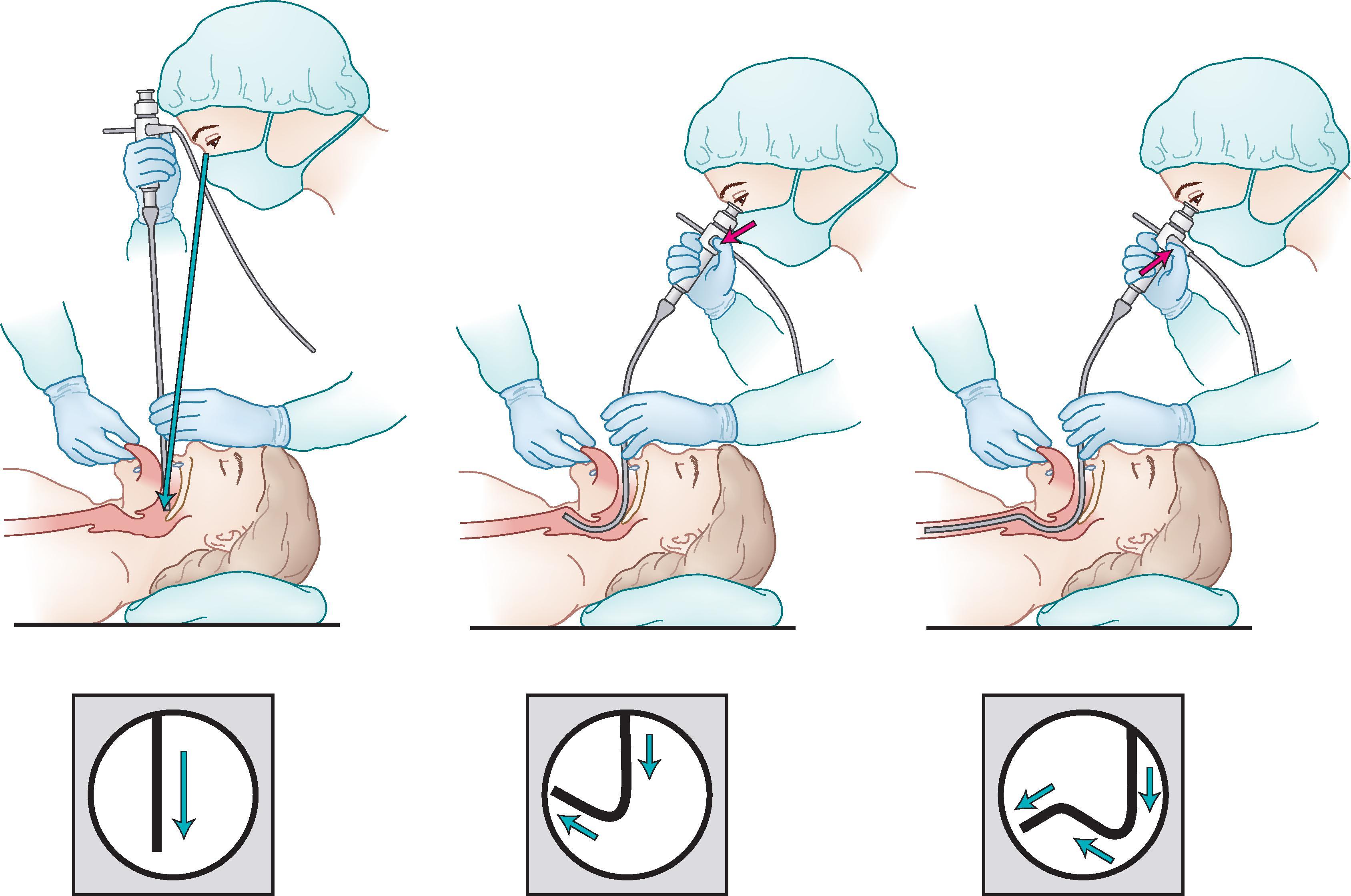
When performing an orotracheal flexible bronchoscopy, it can be difficult to stay in the median sagittal plane, particularly when pharyngeal obstructive flaccidity is present. The difficulty may be overcome with an IOA, assistant aid, or FIS insertion through an SGA while aiming downward to get to the point of upward tip flexion to view the glottis.
During the second phase, while slowly advancing toward the anterior commissure, the posterior part of the glottic aperture will come into view. Continue toward the anterior commissure by keeping the tip of the device in a sharp upward/anterior path. In the absence of anatomic distortions resist the temptation to push the bronchoscope unswervingly in this direction. When the anterior commissure is very close, angle the tip in the third direction, downward toward the widest opening of the larynx. This maneuver aligns the bronchoscope with the anatomic axis of the larynx successively in its supraglottic and infraglottic segments, avoiding contact damage to the mucosa and arytenoid cartilages.
Follow the third direction into the trachea until the tip lies two to three rings above the carina. Do not provoke coughing by being too close to it (often is not anesthetized), but ensure you are able to visualize the carina.
At this point, stop looking at the screen/eyepiece. Instead, look at the patient to judge when the ETT tip is near the larynx. Hold the bronchoscope immobile in your left hand and, with your right hand, slide the ETT forward with the Murphy eye oriented anteriorly if using a PVC ETT (a 90-degree rotation) to prevent it from getting hung up on the arytenoids (statistically, most frequent on the right). , Ask the patient to take a deep breath to open the vocal cords widely, and advance the ETT as you are rotating it. After judging that it is beyond the vocal cords, observe the screen to slide the ETT two to three rings above the carina. Gently inflate the ETT, stabilize it, and remove the bronchoscope by putting it straight into the used vertical holder or hand it to an assistant. Attach the ventilating system, check for P etco 2 , and secure the ETT. A two-point check is advocated before induction of anesthesia: (1) visualizing the ETT in the trachea and (2) confirming P etco 2 . Without either of these checks, proceeding with GA might not be safe.
At any point from the mouth to the trachea, if nothing is recognizable, back up slightly to look around with slow lever motions until anatomic structures are familiar, then proceed again. For very difficult ETT insertions, it is worthwhile to recheck the secured ETT with the bronchoscope, especially after patient positioning, which may cause ETT movement.
Here are some scenarios and suggestions on how to deal with issues.
Question. What do I do when the patient is too sleepy before the FIS insertion and I can’t grab the tongue? Reduce the level of sedation and ask the patient to stick out their tongue. You may also consider applying large suction tubing to it. Slowly draw it out, until grasped with gauze.
Question. The bronchoscope view isn’t clear. Is it fog? It may improve with any of the following: touch the tip on the mucosa ( ); suction via bronchoscope or separate tubing, or both; check the focus dial or eyepiece. If unsolved, remove the bronchoscope and clean the tip by carefully holding the tip tightly near its end and gently wiping it with alcohol.
Question. What if I can’t look laterally because the lever only moves the tip up and down? Rotate both hands equally, clockwise for right (if supine) and counterclockwise for left. Then lever it. As an alternative, loosen the handgrip between the thumb and two fingers on the distal bronchoscope insertion section to avoid bronchoscope torque and damage while simultaneously rotating the handle.
Question. The bronchoscope tip is stuck on the posterior pharynx. What do I do if I can’t get by the epiglottis? Ask the patient to stick out their tongue or the assistant to pull the tongue out more and/or perform jaw thrust ( Fig. 24.25 ). As an alternative, try moving the tip more laterally and caudally to angle in under the epiglottis or assist with another airway device to lift the epiglottis (see combo with DL [25], ETT [24], stylet).
Question. What do I do if the patient keeps gagging or coughing as the bronchoscope advances? Consider correcting inadequate LA blocks, or use the “spray as you go” technique.
Question. What do I do if the patient has too many secretions and/or blood and I can’t see? Use one or two suctions continuously. Direct a straightened FIA midline and posterior, equal to two-thirds of the mouth-to-ear distance. Turn the room lights down or off, angle the tip caudally, and use FIS light transillumination, similar to a lighted stylet ( Fig. 24.28 ). Once in the trachea, suction via the bronchoscope until tracheal or carina reaction is observed or those structures are visualized. If unsure, insert an epidural catheter down the working channel for P etco 2 analysis. There are a number of alternatives. (1) Use a VAL for ATI instead, allowing a wider field of view, easier ability to suction, and a lower probability of the image becoming obstructed. (2) Insert a second-generation SGA to seal the periglottic area. Suction the ventilating lumen of the SGAs, ventilate, and check the P etco 2 waveform. Advance a bronchoscope until near the carina. (3) Insert a long (≥80 cm) guidewire into the bronchoscope to extend it 3 cm past its tip. Tape it proximally. Tape the ETT to the FIS so that the FIS tip ends just before the ETT tip. With simultaneous oral suctioning, the FIS may stay clear of the soiling, and the wire may be directed to the glottis. Once it goes 8 cm past the glottis, quickly advance the FIS and then the ETT. Rapidly inflate and suction the ETT. (4) Use retrograde-flexible scope–assisted intubation (see Combinations). (5) At any point, if oxygenation, ventilation, or aspiration threatens, consider a surgical airway.
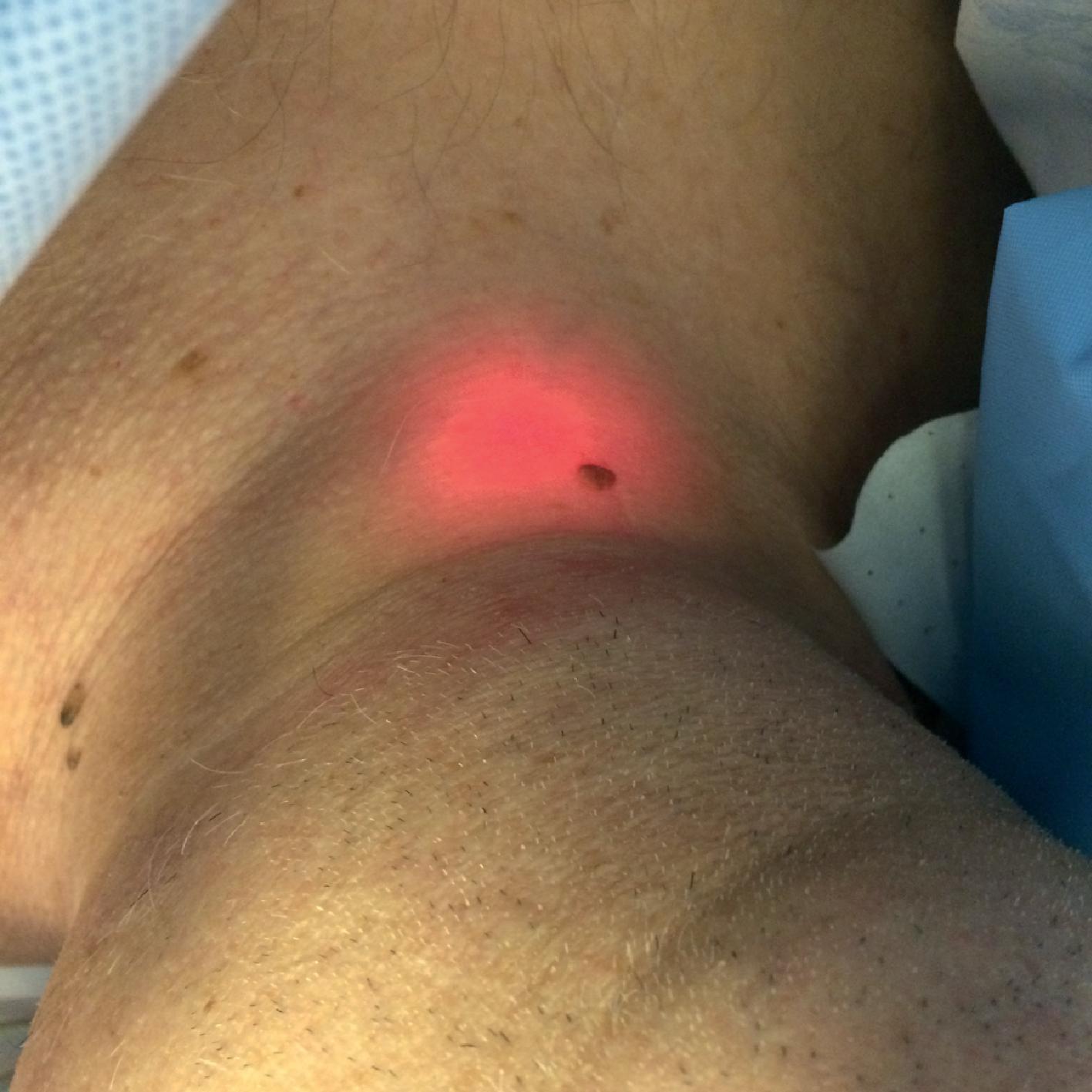
Question. What do I do if the bronchoscope passes the glottis and I can see rings? The airway is getting very narrow and the patient is getting agitated and desaturating a bit. It may be a compromised airway. Tracheal stenosis or obstructive pathology causes inadequate room around the bronchoscope for ventilation. Do not insufflate oxygen through the bronchoscope in case ventilation volumes cannot exit (pneumothorax risk). Speed up the process to intubation and remove the FIS as soon as possible. Alternatively, if an adult FIS was used, remove it and use a pediatric one.
Question. What do I do if the bronchoscope is clearly right above the carina but I can’t slide the ETT into the trachea? Withdraw the ETT 1 to 2 cm, keep the convex side right, and advance with a rotational movement while asking the patient to take a deep breath. If unsuccessful, apply tongue pull/jaw thrust, repeat, and/or rotate the ETT 180 degrees clockwise the other way. Han’s study found that these maneuvers could double success rates for first-attempt ETT passage with an FIS; oddly, sometimes, even releasing jaw thrust helps. Alternatives include trying slight cricoid pressure or neck flexion ; removing the FIS and trying a smaller ETT or a centrally curved, soft-tip ETT; inserting a pediatric FIS on an Aintree Intubation Catheter (Cook Medical Inc., Bloomington, IN) and sliding the ETT over both (lessens diameter disparity); or using a nasotracheal approach.
Question. I pushed the ETT forward after successfully placing an FIS. Despite every maneuver, the ETT wouldn’t enter. What should I do? Back the bronchoscope out. If more than minimal resistance is felt, withdraw the bronchoscope/ETT carefully as a unit. The bronchoscope may have exited through the Murphy eye. Strong attempts at removing the FIS can damage the outer skin as a result of catching sharp Murphy eye edges ( Fig. 24.29 ). However, the ETT may be too big. In this case remove the scope and start again using a different approach.
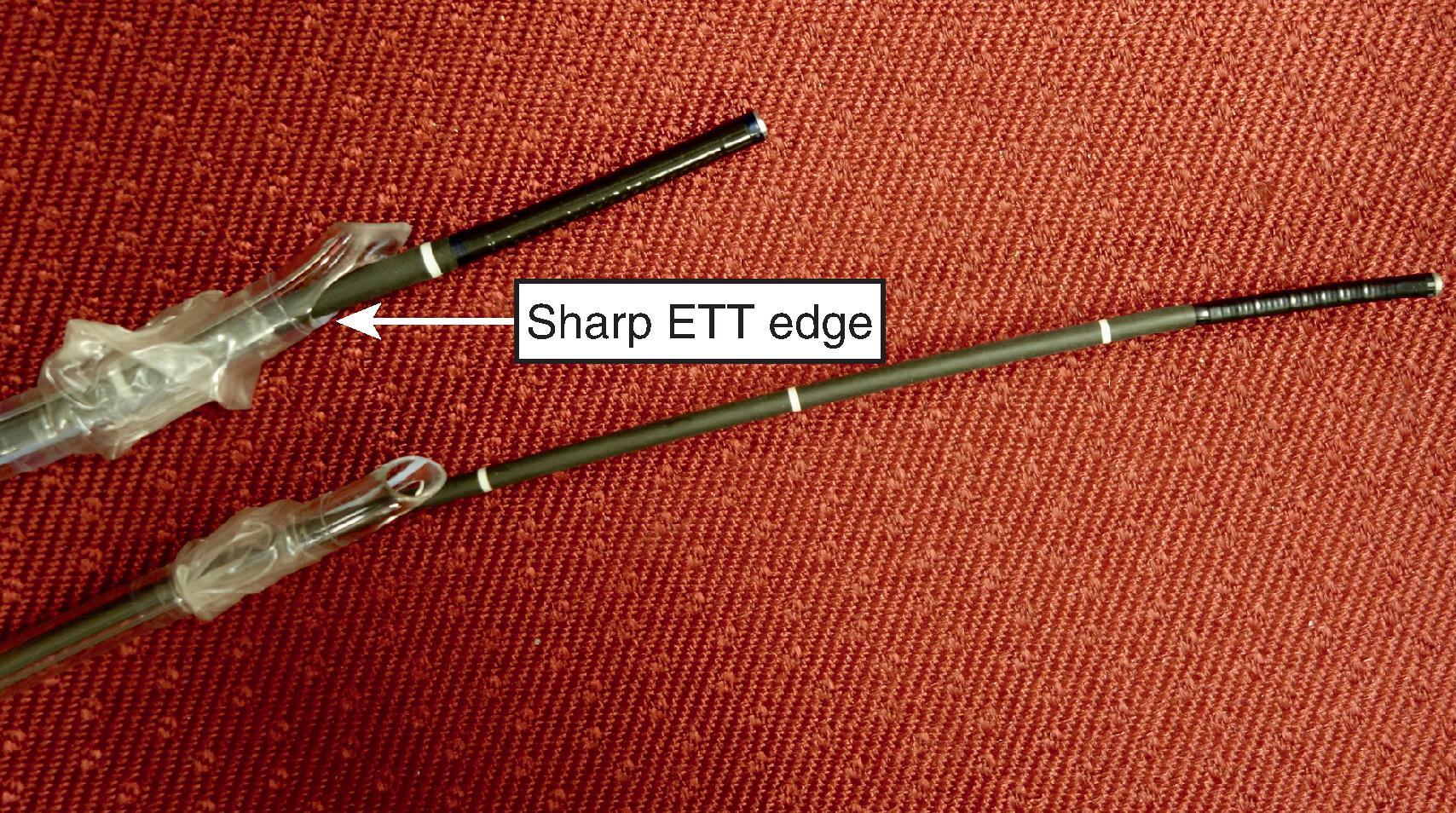
Become a Clinical Tree membership for Full access and enjoy Unlimited articles
If you are a member. Log in here